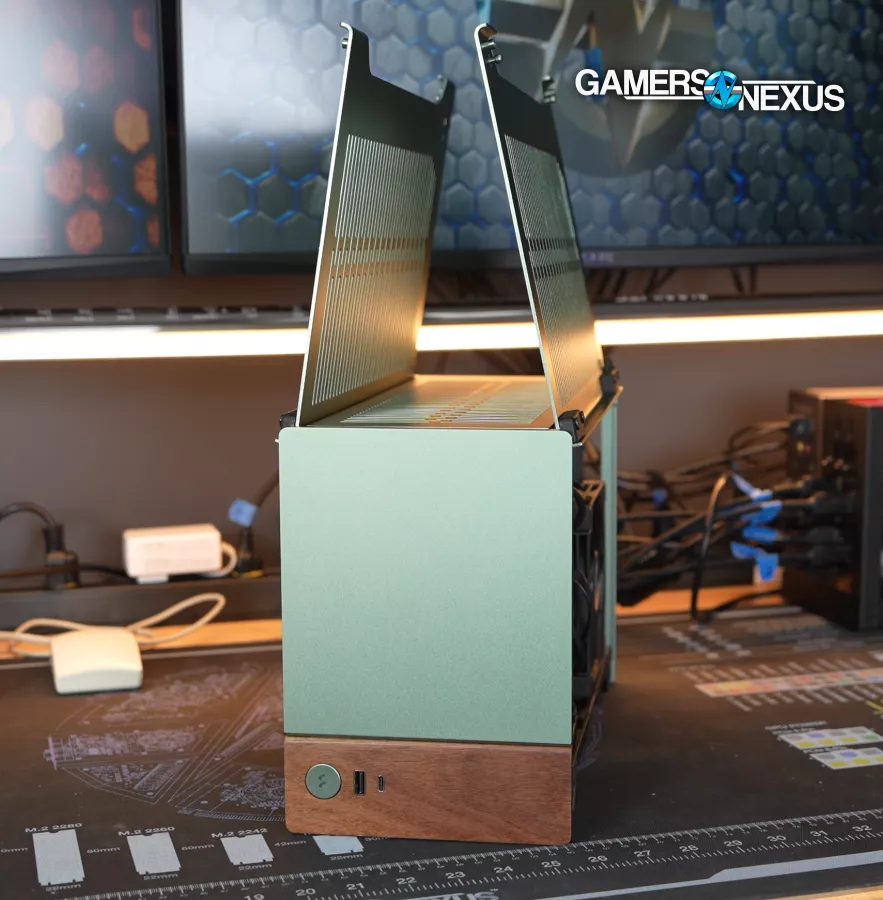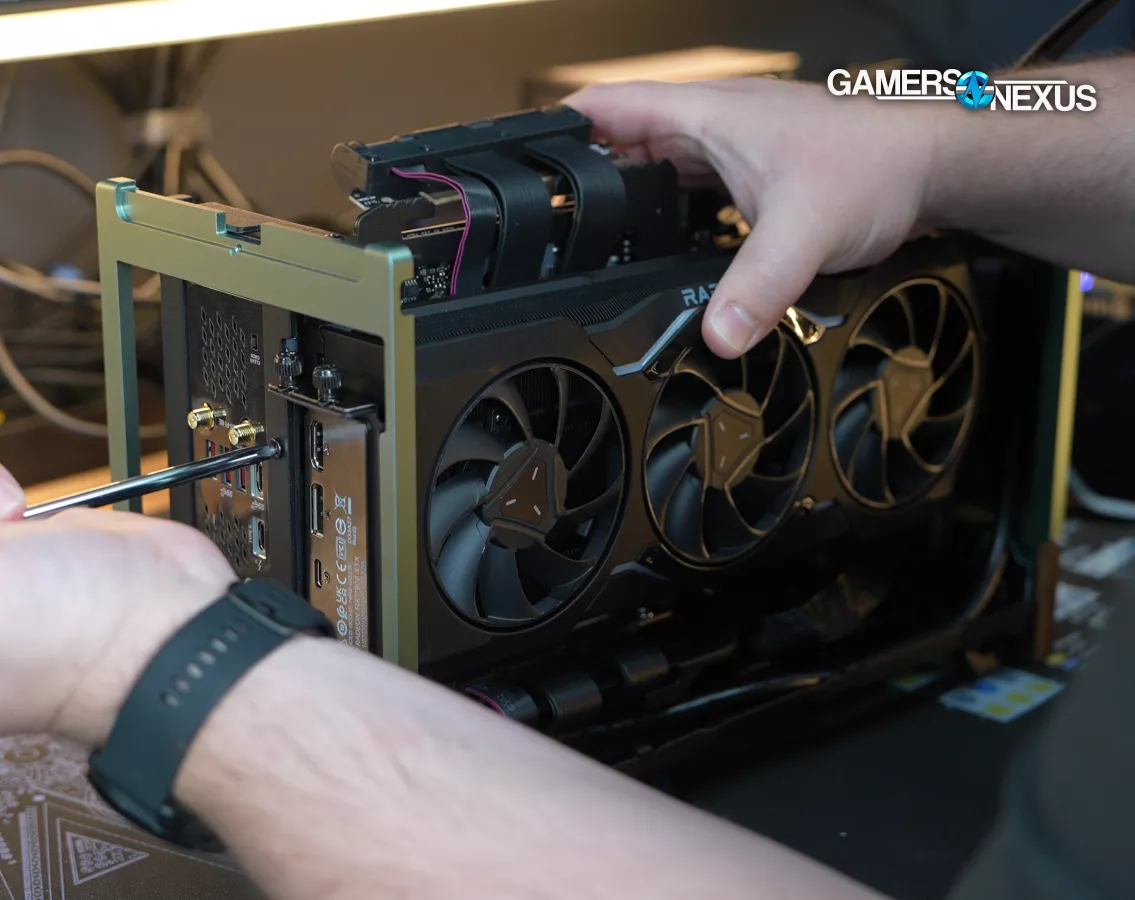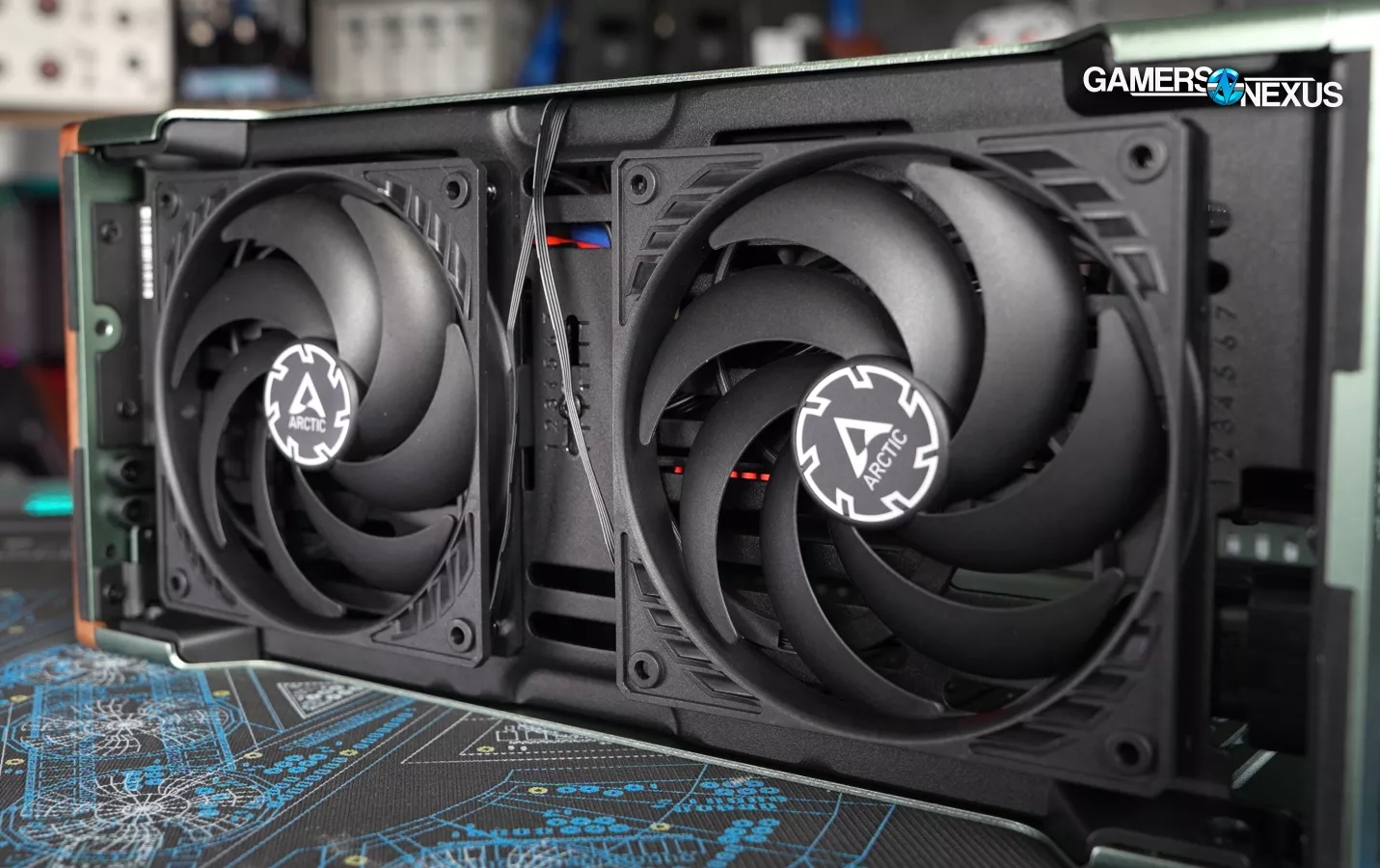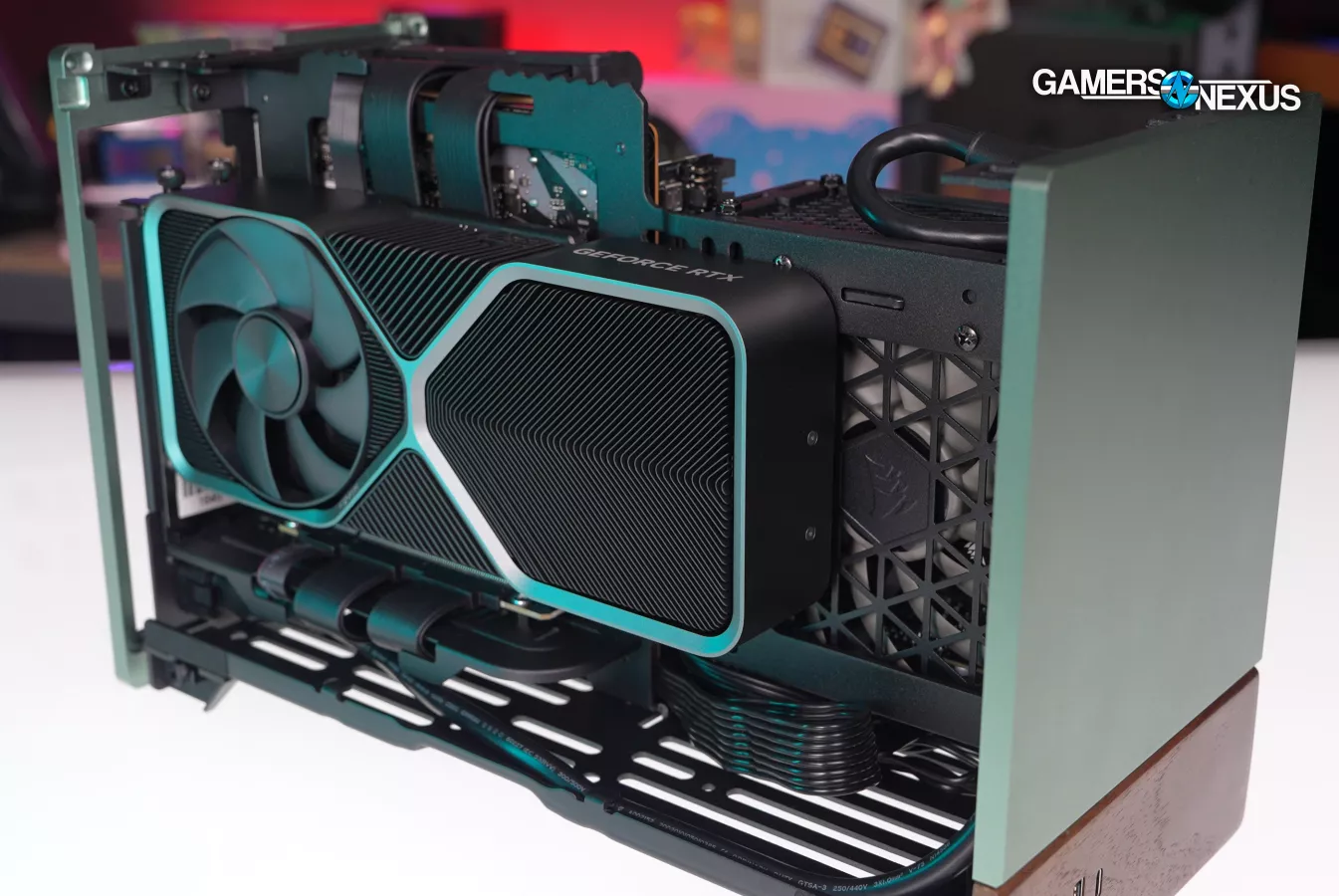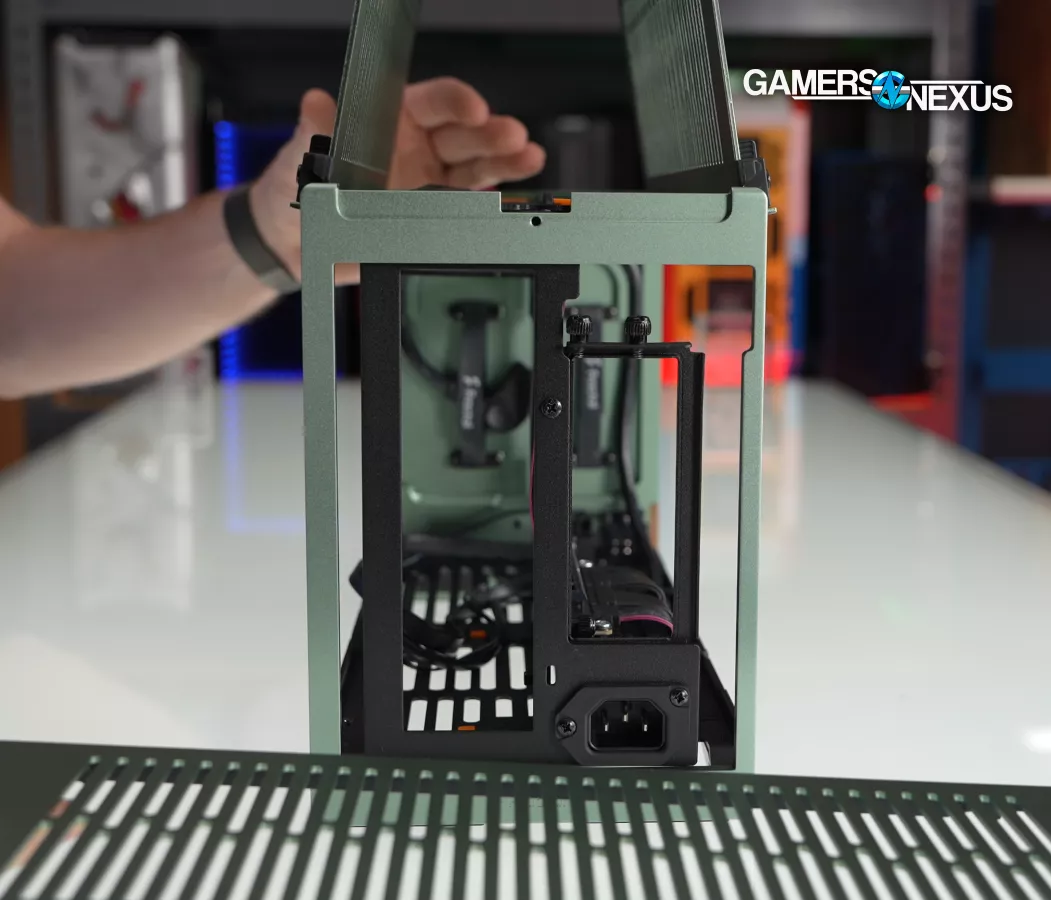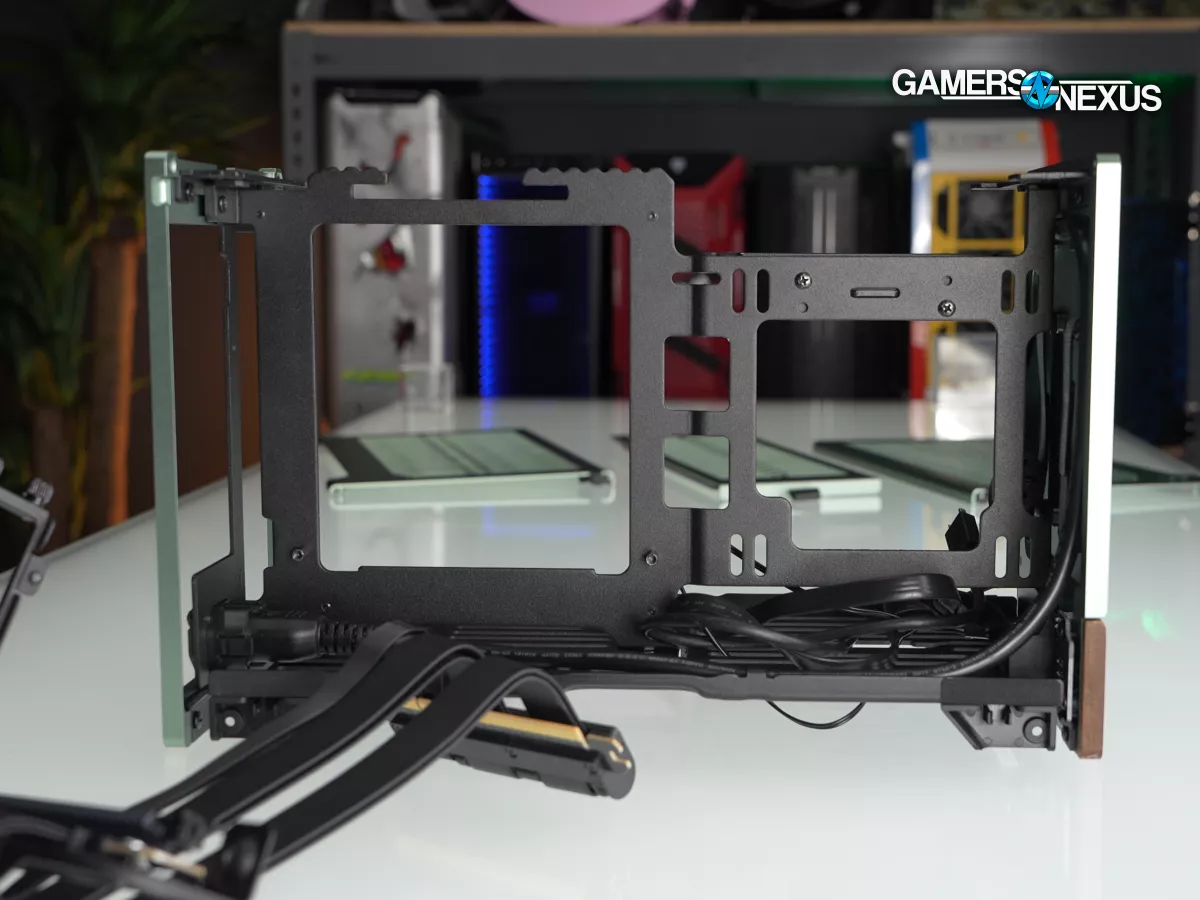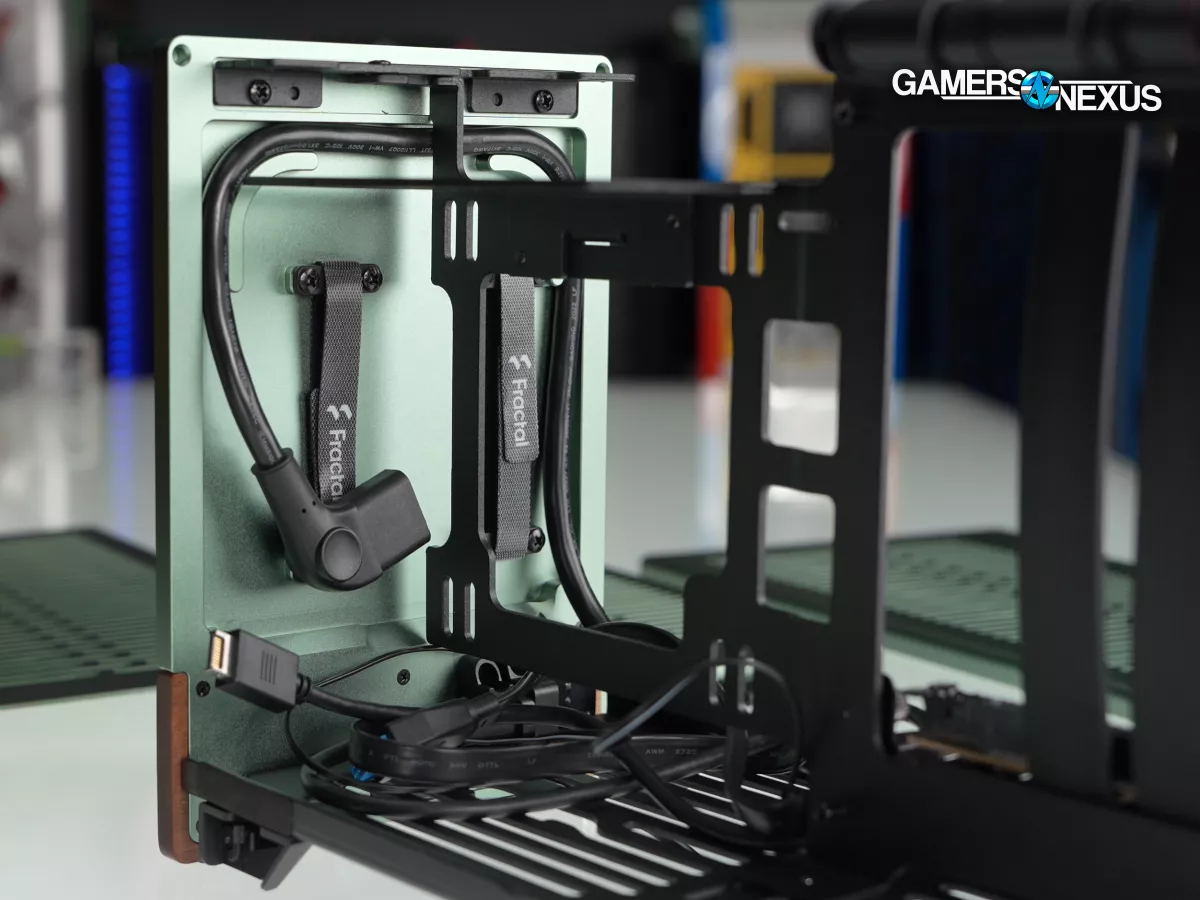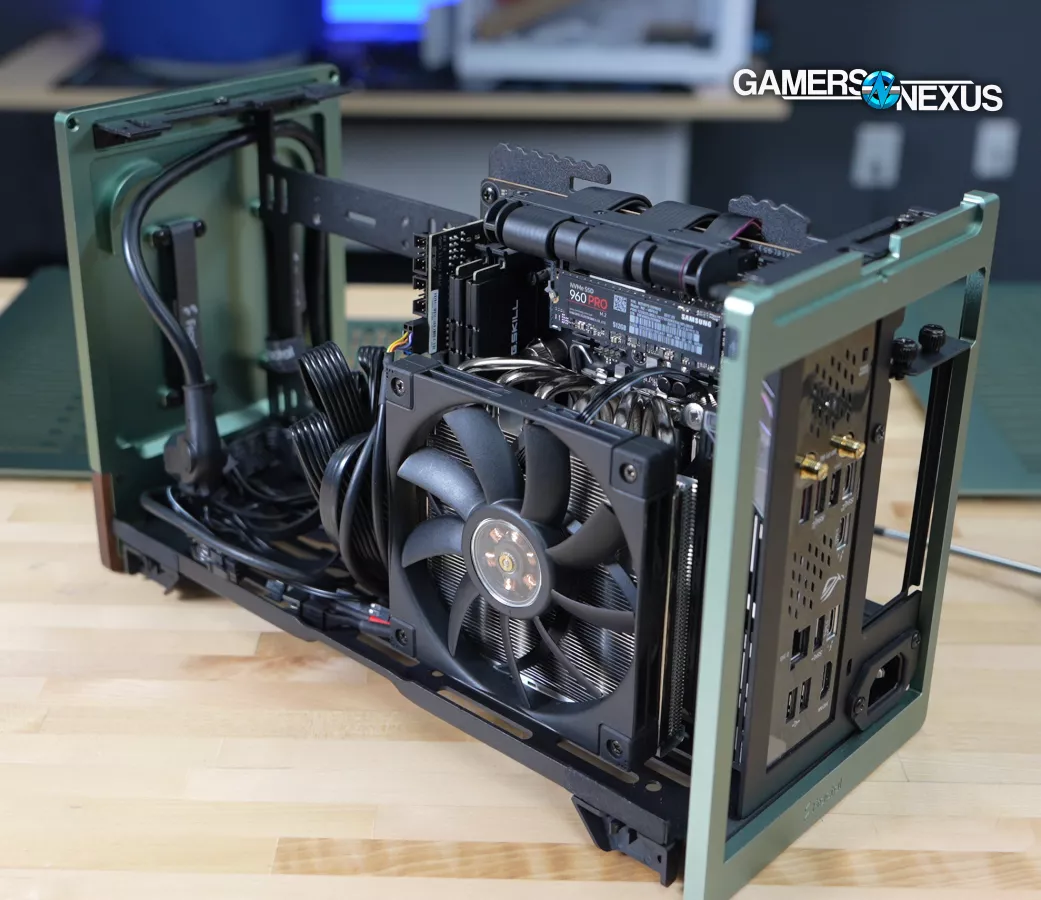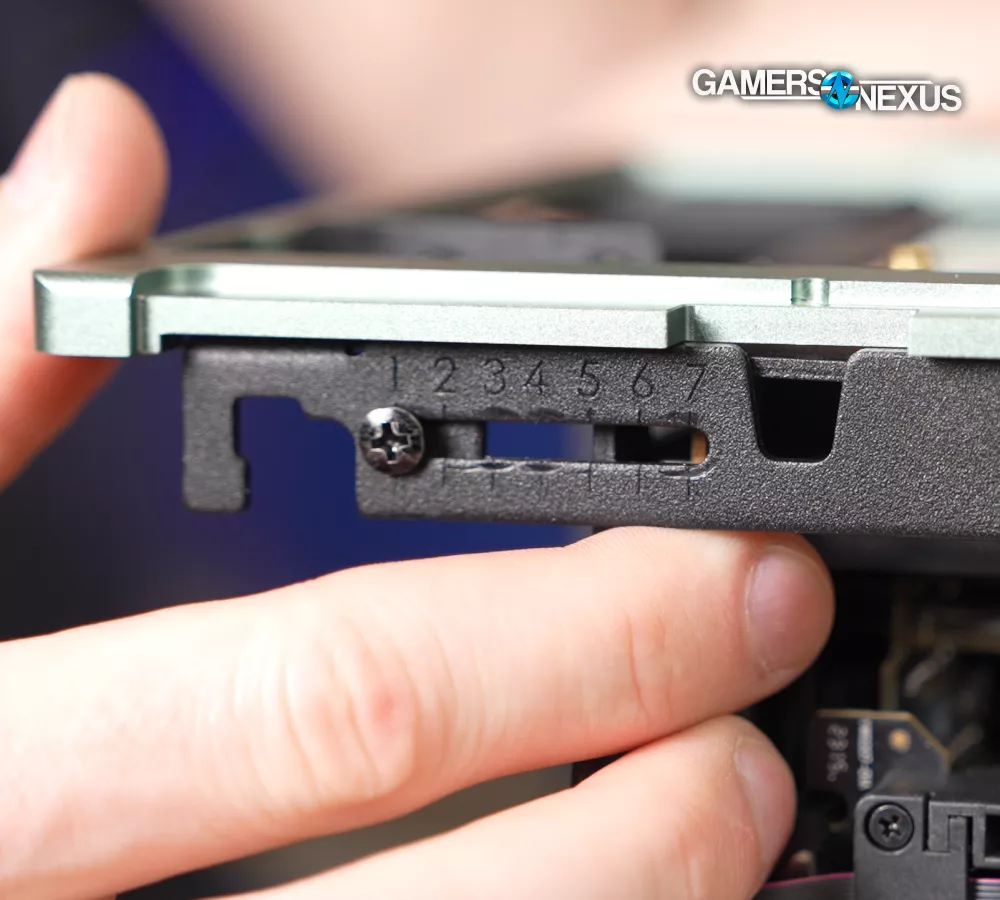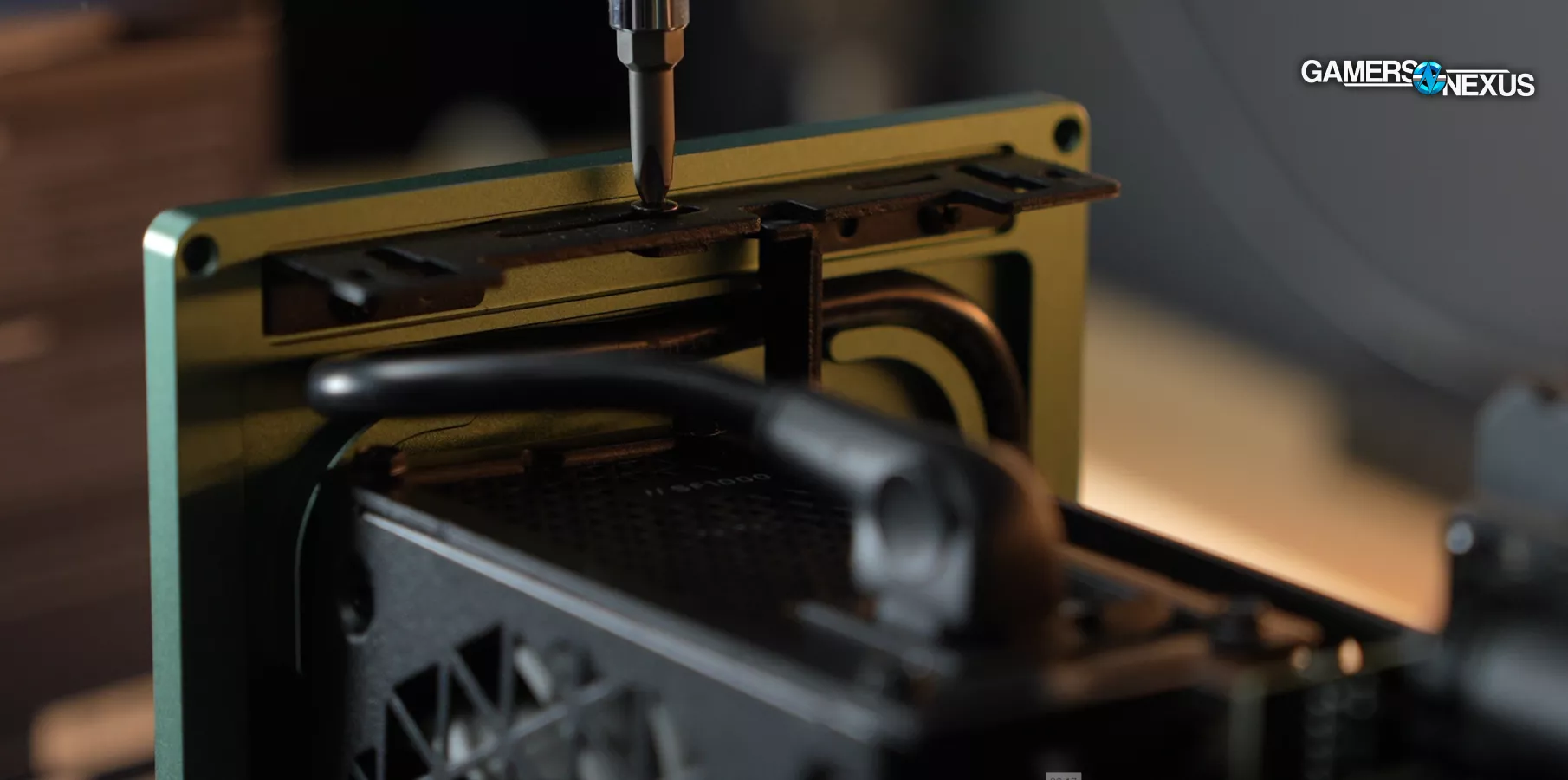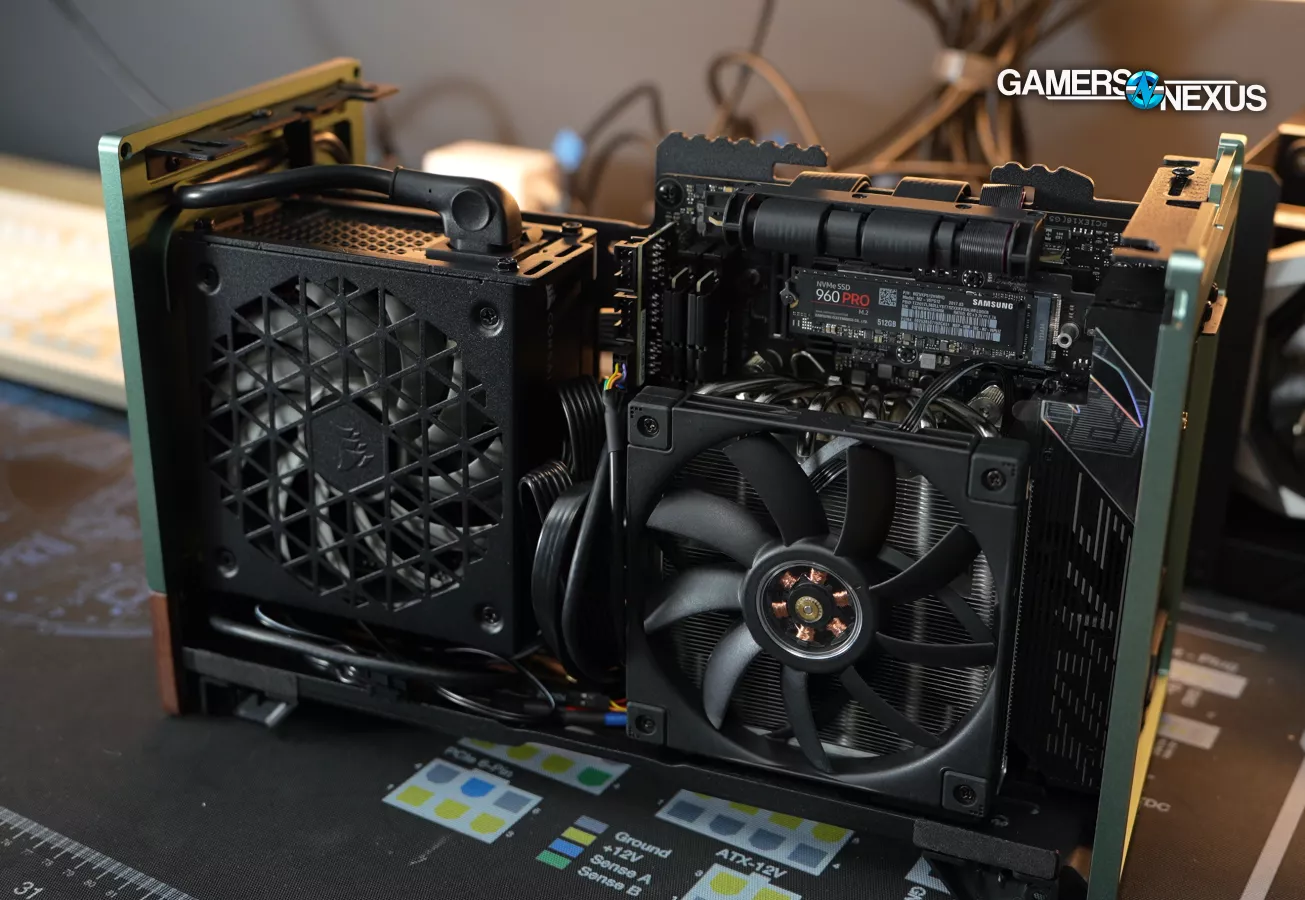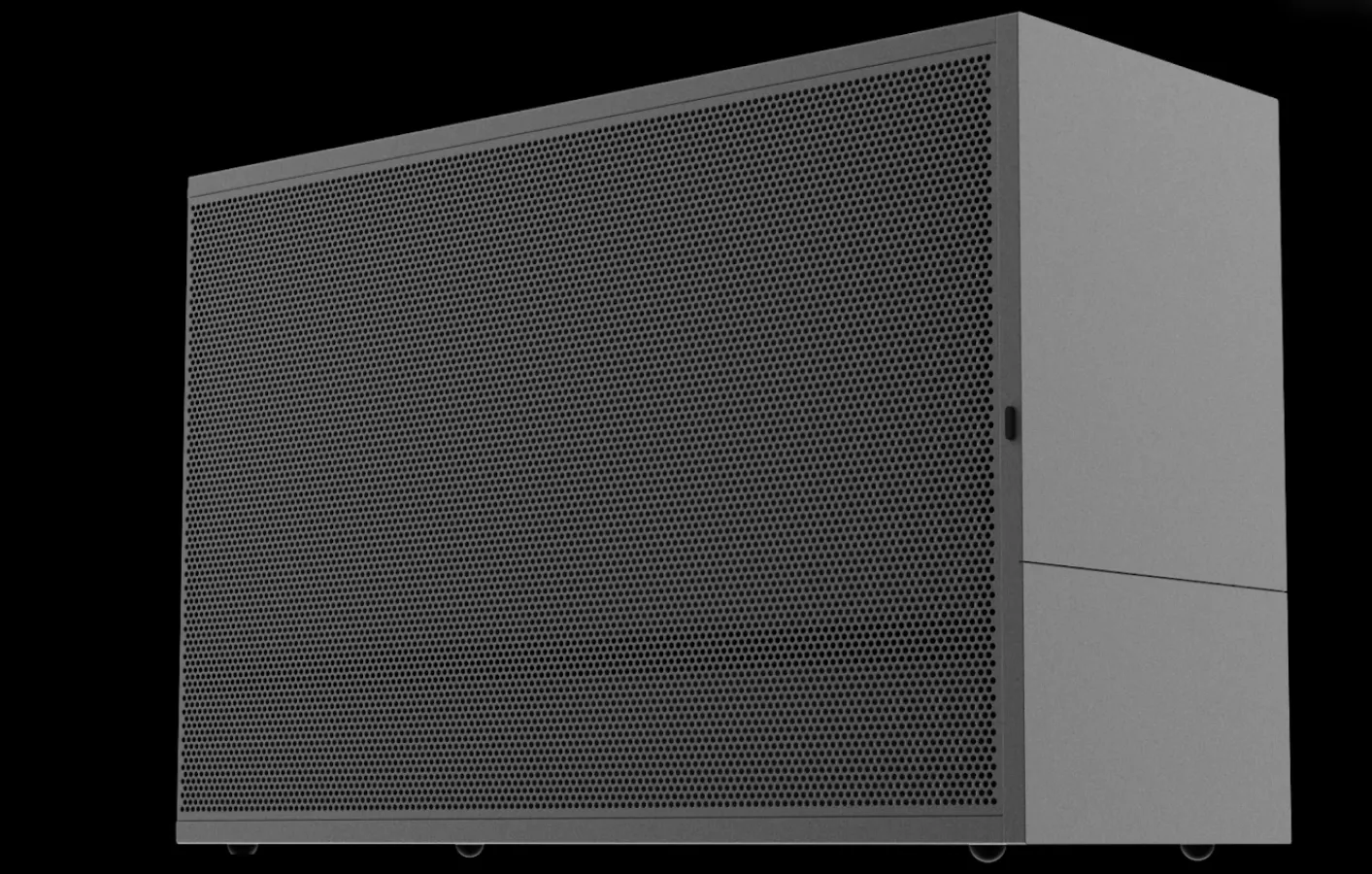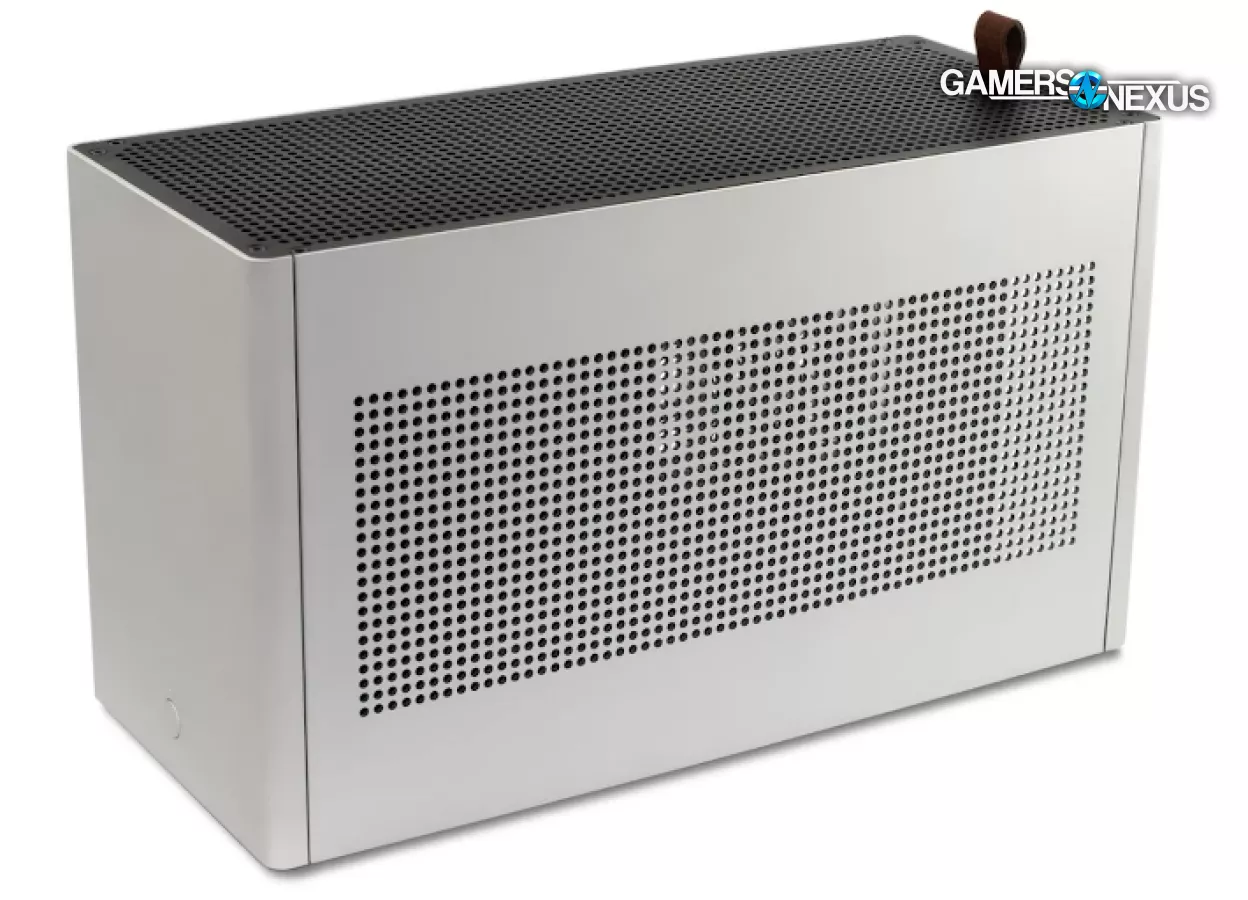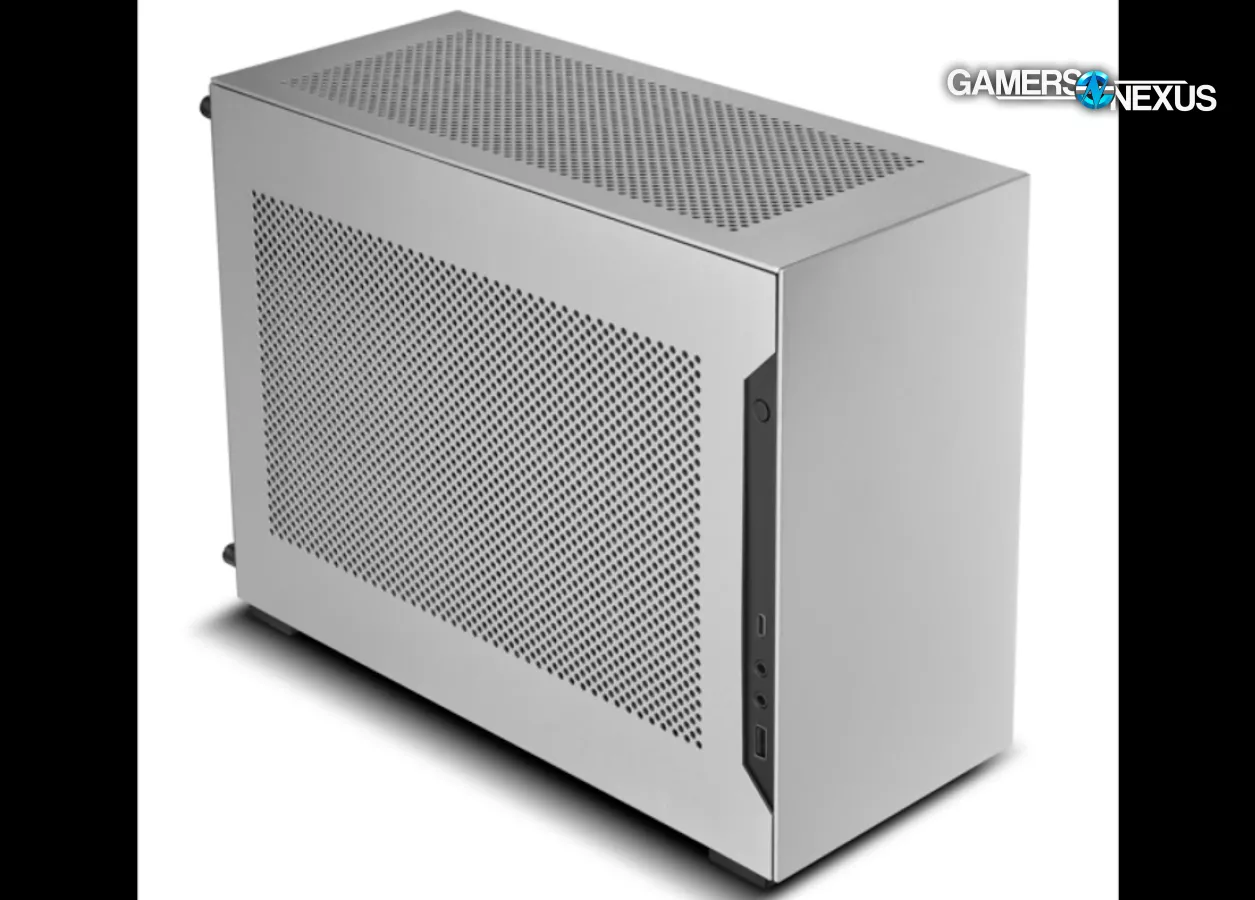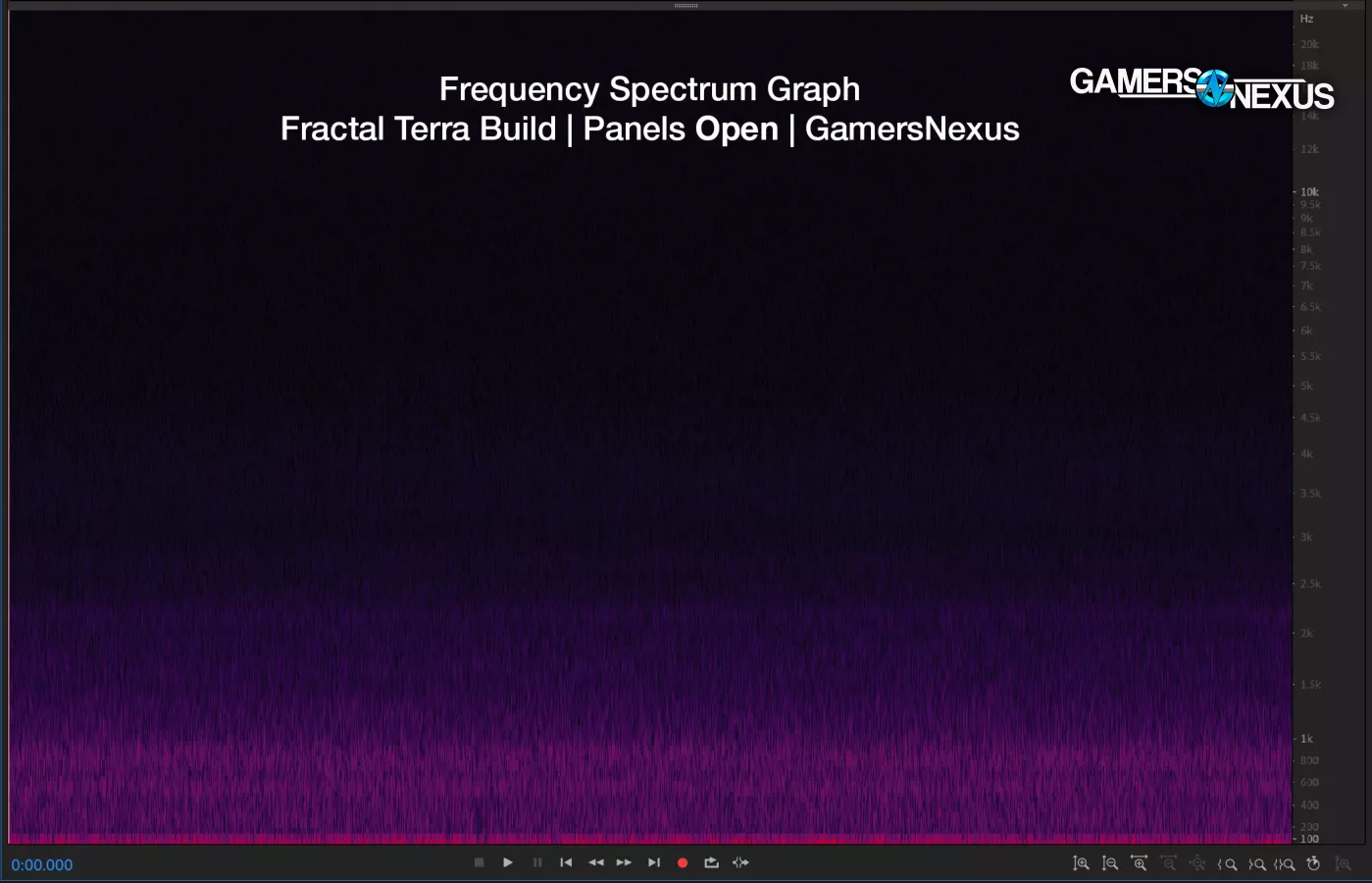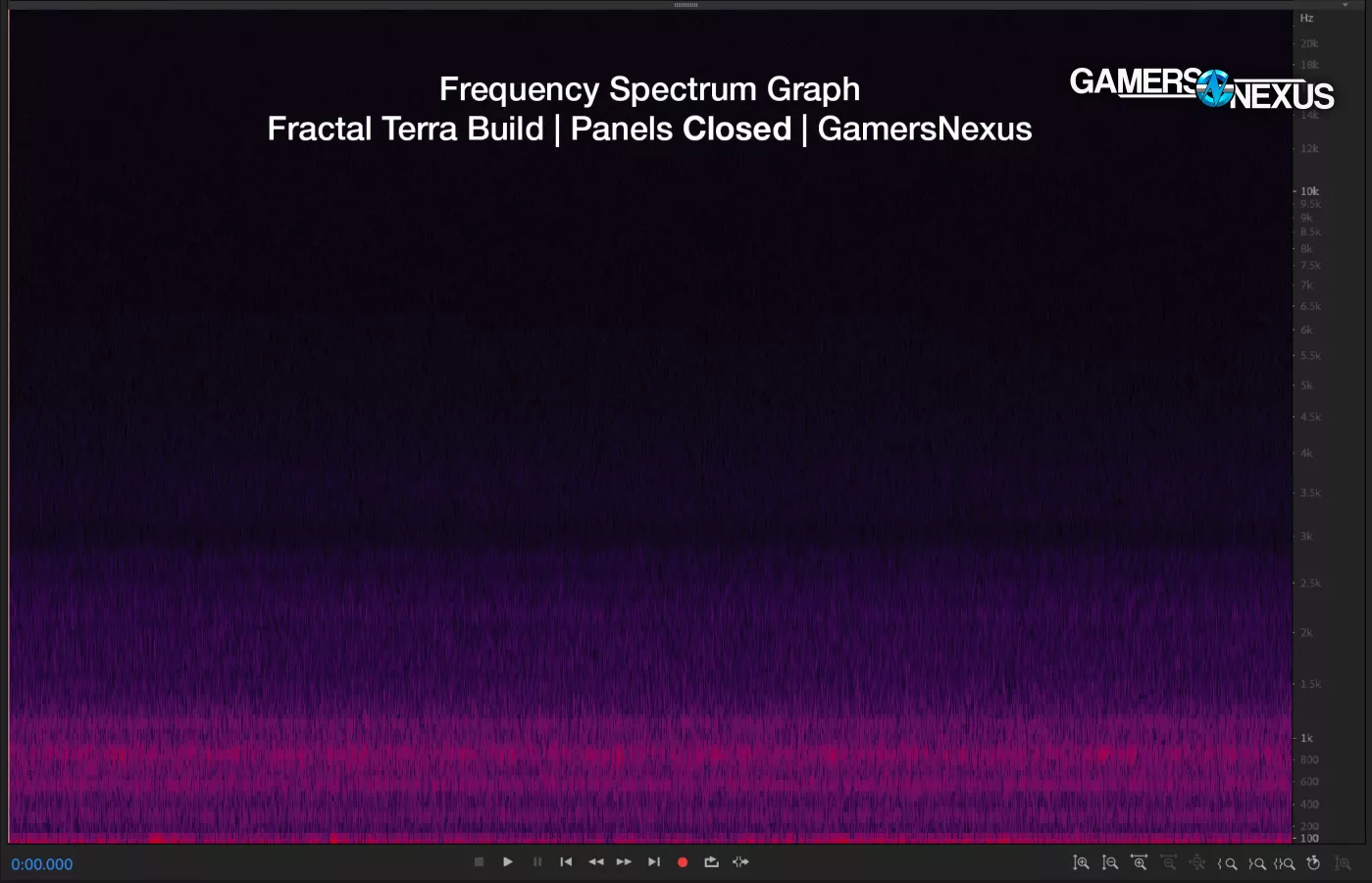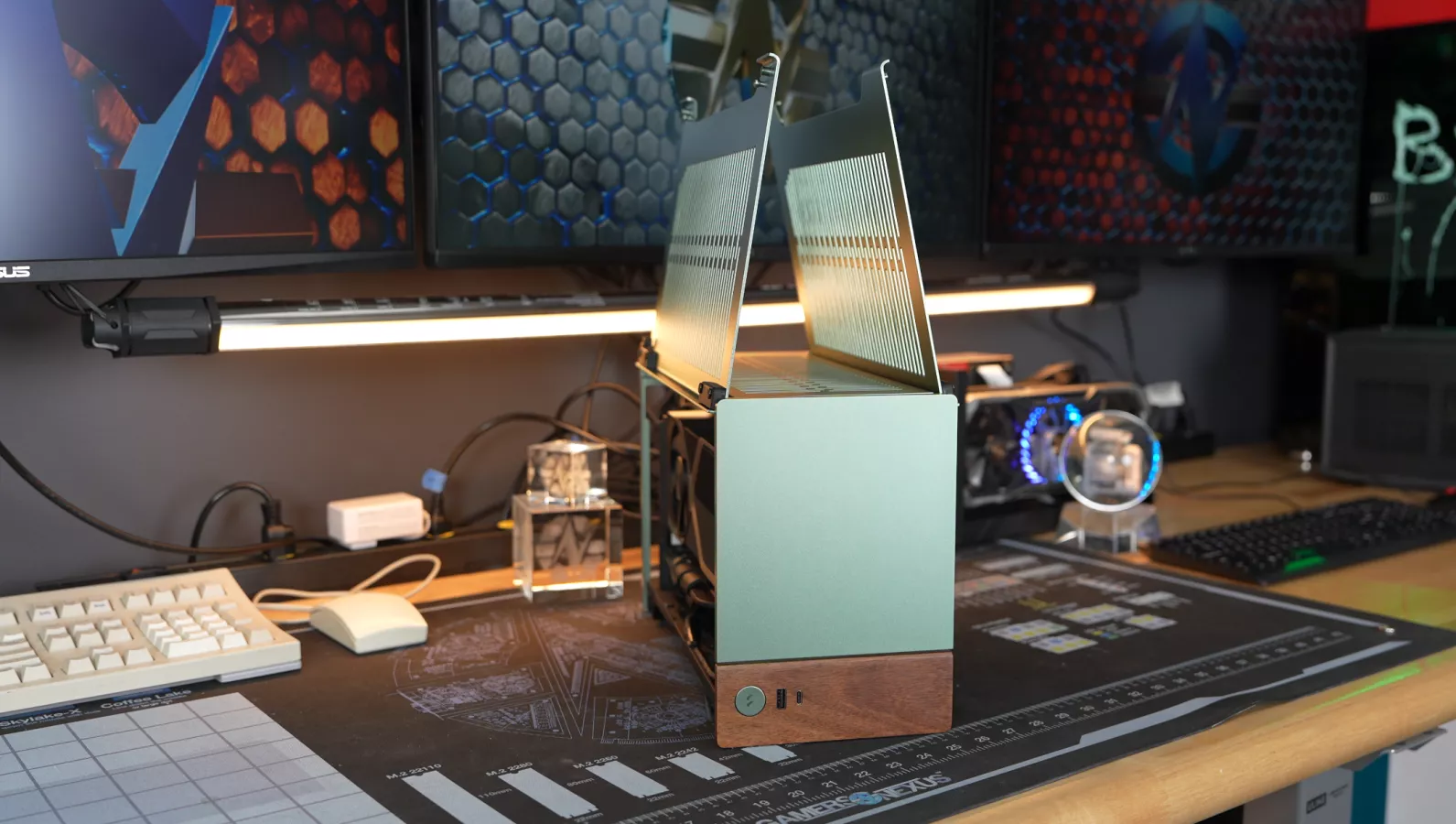
Fractal Terra Mini-ITX Case Review: Build Quality, Thermals, Acoustics, & Cable Management
Last Updated:
The Fractal Terra Mini-ITX case was the first through our revamped suite of ITX reviews.
The Highlights
- The Fractal Terra is a sandwich-style case with aluminum & wood
- Perforation choices in the side panels can cause undesirable acoustics, depending on fan design.
- Build quality on the Terra is overall exceptional
- Original MSRP: $180
- Release Date: May 31, 2023

Today, we're reviewing the Fractal Terra mini-ITX case. It has some extremely unique features, but also some extremely unique noise characteristics as a result of the slat design on the panels. In the video, you'll notice that when we replace the side panel with something perforated hexagonally or circularly, the noise profile of the case is significantly better -- it’s not only quieter, but of a more tolerable frequency. We’ll show numbers for that in our noise chamber later. All the audio comparisons will be in the video.
Slats are more prone to causing fan noise issues due to the angle of entry created – something true of the O11 Dynamic also. But we’ll come back to that.
Credits
Test Lead, Host, Writing
Steve Burke
Testing & Writing
Jeremy Clayton
Video Production
Vitalii Makhnovets
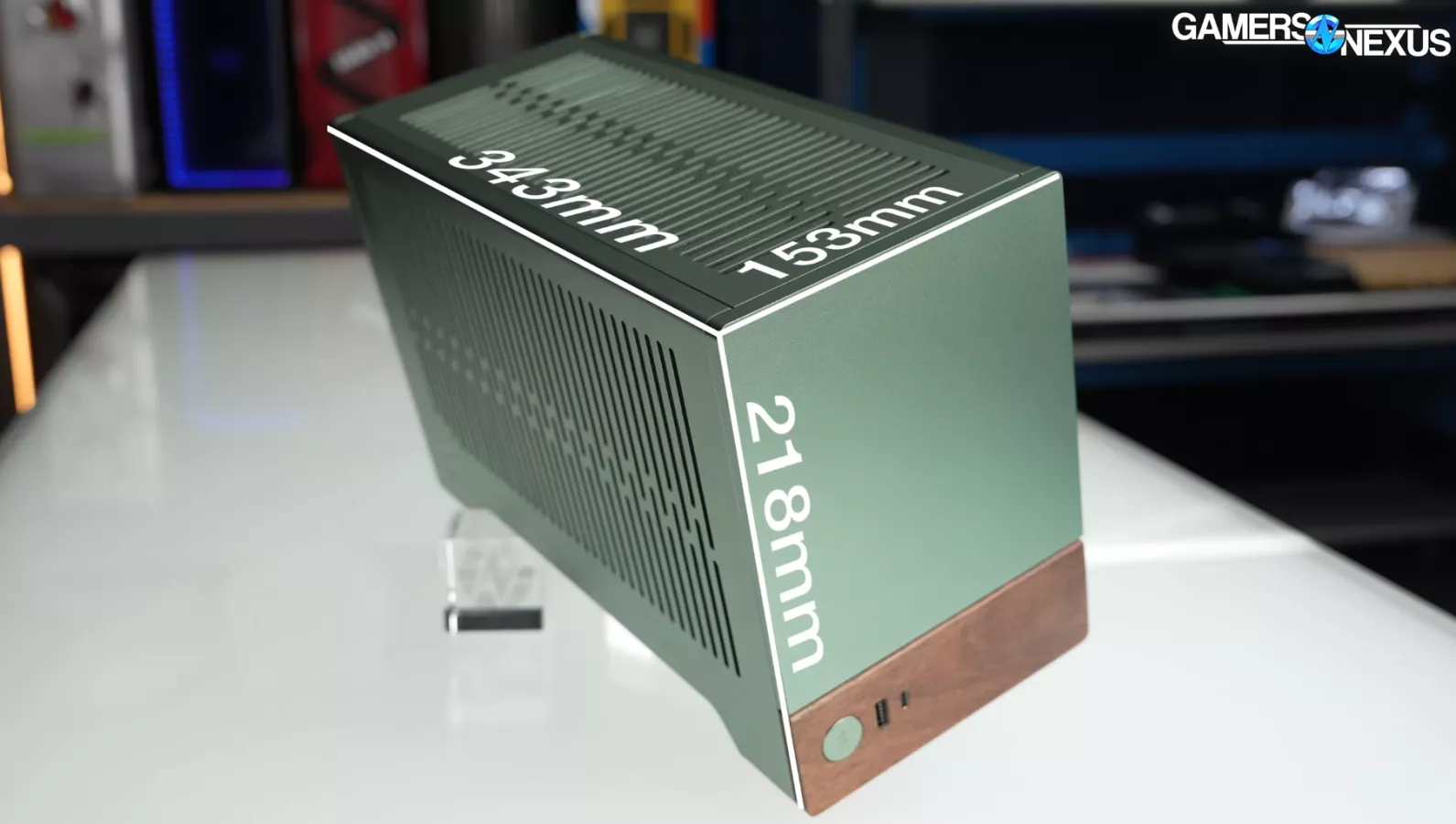
The Terra is a “sandwich” mini-ITX case with unique features like removable gull-wing doors and top panel for access, a movable spine for flexible internal fitment, and touches of wood and leather for some style from alternative materials. This case is $180 in a forest green, silver, or graphite.
Fractal Terra Mini-ITX Case Specs
| Model Name | Fractal Terra |
| Colors | Jade Green Silver Graphite (black) |
| SKU | Jade: FD-C-TER1N-03 Silver: FD-C-TER1N-02 Graphite: FD-C-TER1N-01 |
| Dimensions | 343 x 153 x 218 mm (with protrusions) 343 x 153 x 198 mm (without protrusions) |
| Weight | 3.1 kg |
| Volume | 10.4 L (excluding feet) 11.4 L (including feet) |
| CPU Cooler Clearance | Supports up to 77 mm CPU cooler (Max CPU Cooler configuration) Supports up to 48 mm CPU cooler (Max GPU configuration) |
| GPU Clearance | Supports ≤322 mm long GPUs with up to 77 mm width and 131 mm height (Max GPU configuration) OR ≤322 mm long GPUs with up to 67 mm width and 145 mm height (Max GPU configuration) |
| GPU Max Length | 322mm |
| PSU Max Length | 130mm |
| PSU Form Factor | SFX-L/SFX |
| Included Fans | None |
| Fan Compatibility | 1x 120mm Bottom |
| Front I/O | 1x USB Type-C 20Gbps (USB 3.2 Gen 2x2) 1x USB Type-A 5Gbps (USB 3.0) 1x Power Button |
| 2.5" Mounts | 2 |
| Motherboard Compatibility | Mini-ITX |
*specs table taken from manufacturer’s website. This table has not been changed from the manufacturer's listing. Any issues we take with the table will be discussed below.
Overview
Fractal has been on somewhat of a win streak with its cases. The Torrent led into the North, and both landed on our top recommendations for cases. That’s a big change from the older super toned-down Define series, and it’s revitalized the company in the DIY market.
Fractal Terra PC Build Photo Gallery
Main Features
Ease-of-access on the Terra is good: The doors open, shut, and remove easily. The central spine runs from front-to-back inside the case and can be adjusted left to right by 30mm to allow for more room either on the GPU or CPU side. The adjustment points are marked 1 through 7, but there are no steps or catches, so it can be set between the marks freely. In general it works well, and the only con is that when tightening a screw, it tends to move the spine a little bit – so the freedom costs some structure there.
Competition
The Terra’s direct competition would be the $220 FormD T1 Sandwich. Fractal obviously drew inspiration from this case, also a sandwich style, but with a more traditional mesh panel. The Louqe Ghost S1 is another direct competitor, which happens to be priced at $180 on sale at the time of writing – exactly the same as the Terra. There are also less expensive choices like this DAN / Lian Li A4-H2O at $155.
We’re working towards reviewing some of these as well. The DAN Case is already on our list. As we’re just restarting our ITX case testing, the Terra will be the one to start re-building our database -- but the experience from over a decade of case reviews all carries over here, just with renewed focus on trying to identify “pain-in-the-ass factor” aspects of the build process. That’s what really matters: The most important part of ITX reviews are the sections on the building process and ease-of-installation features.
The Build
Getting into those: The Terra is a shoebox-sized “sandwich” layout. In this case, the components are back-to-back on either side of a 2.5mm thick steel “spine” -- for reference, a lot of ATX case motherboard trays max-out at 1mm -- so the structural support is definitely present. An included PCIe riser connects the main compartment with the video card. The movable spine means that GPU and CPU cooler clearances are variable based on spine position, enabling sacrificing space for one to give to the other.
Simplifying the sliding scale, the maximum CPU cooler height is 77mm.
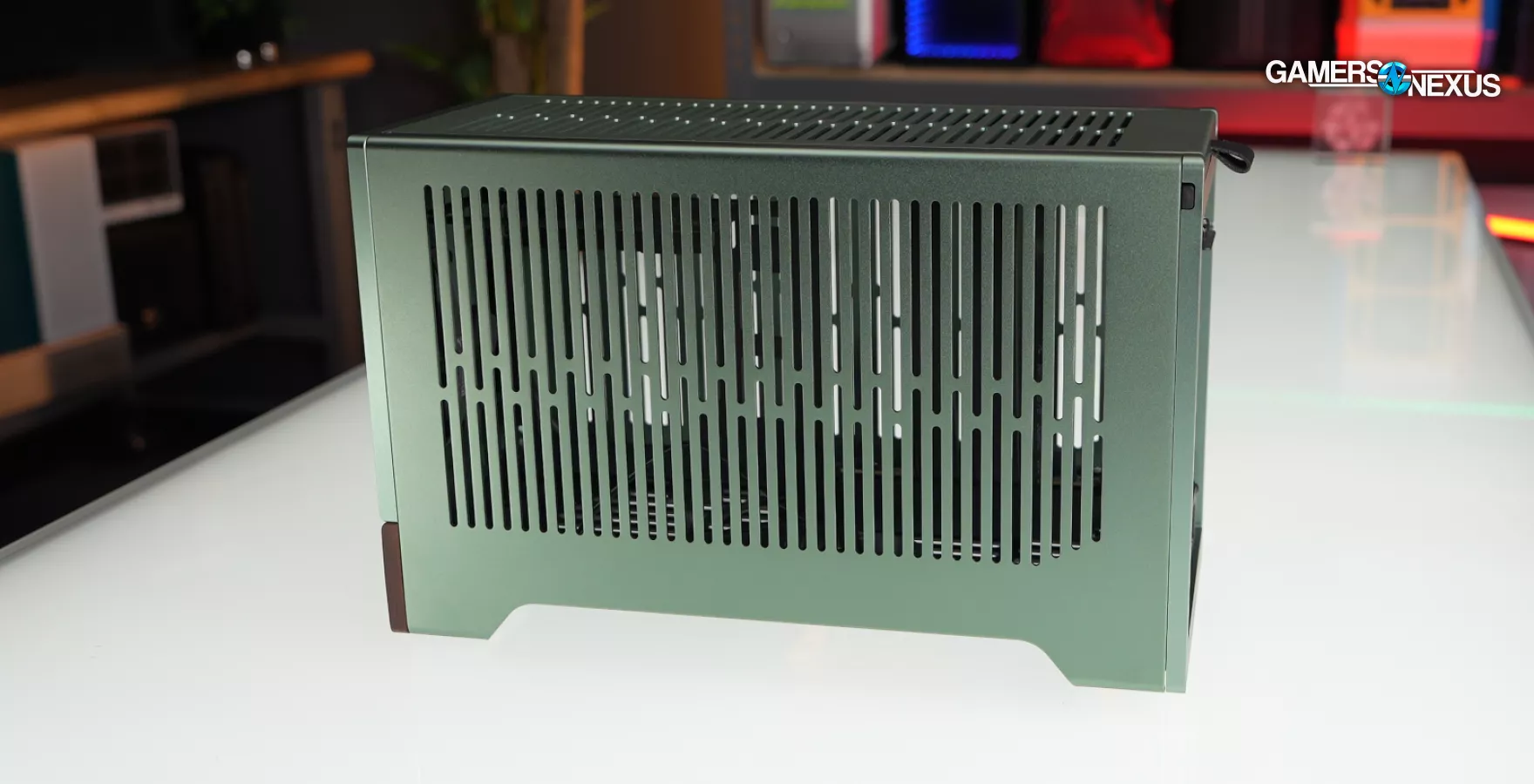
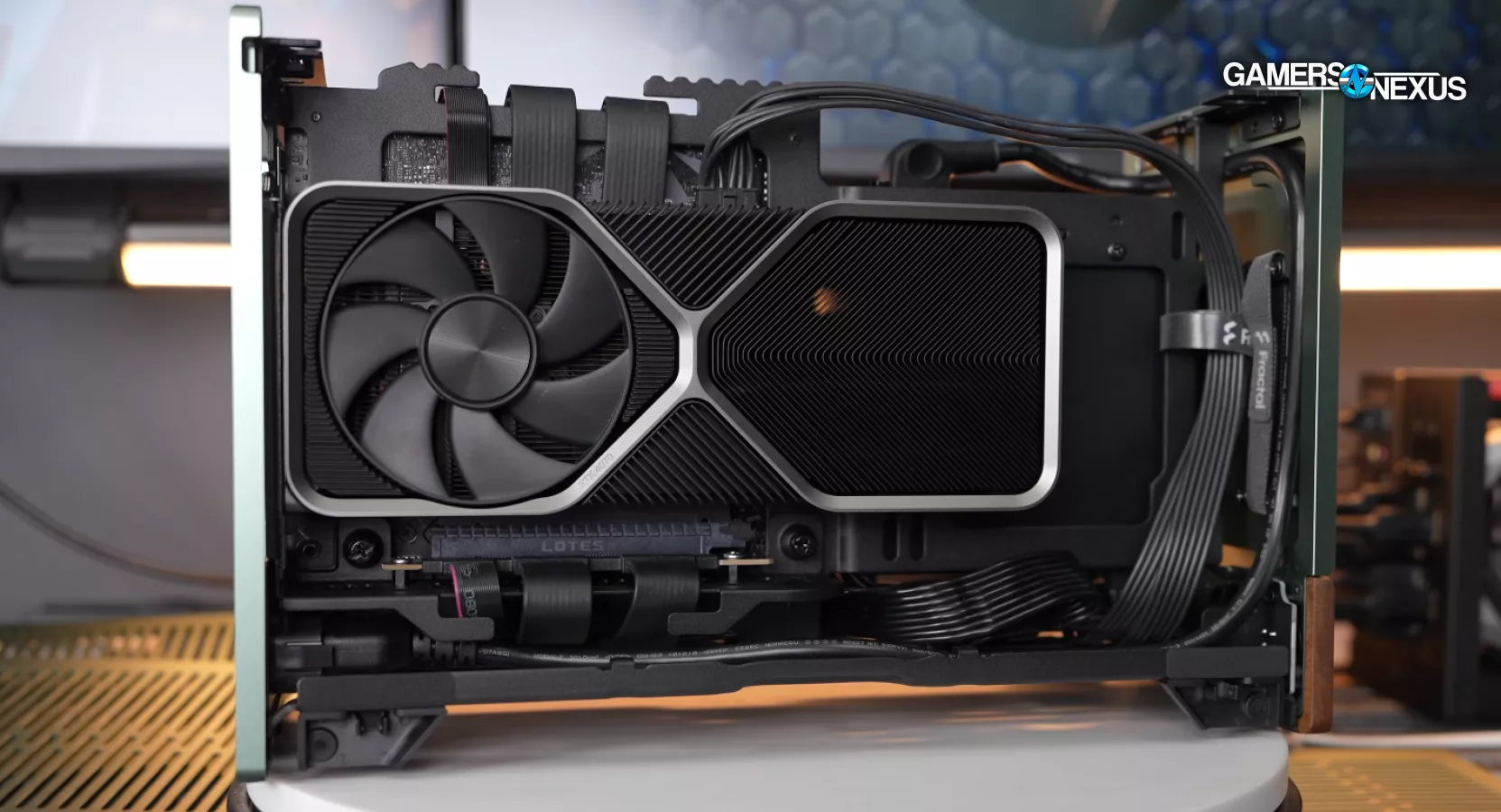
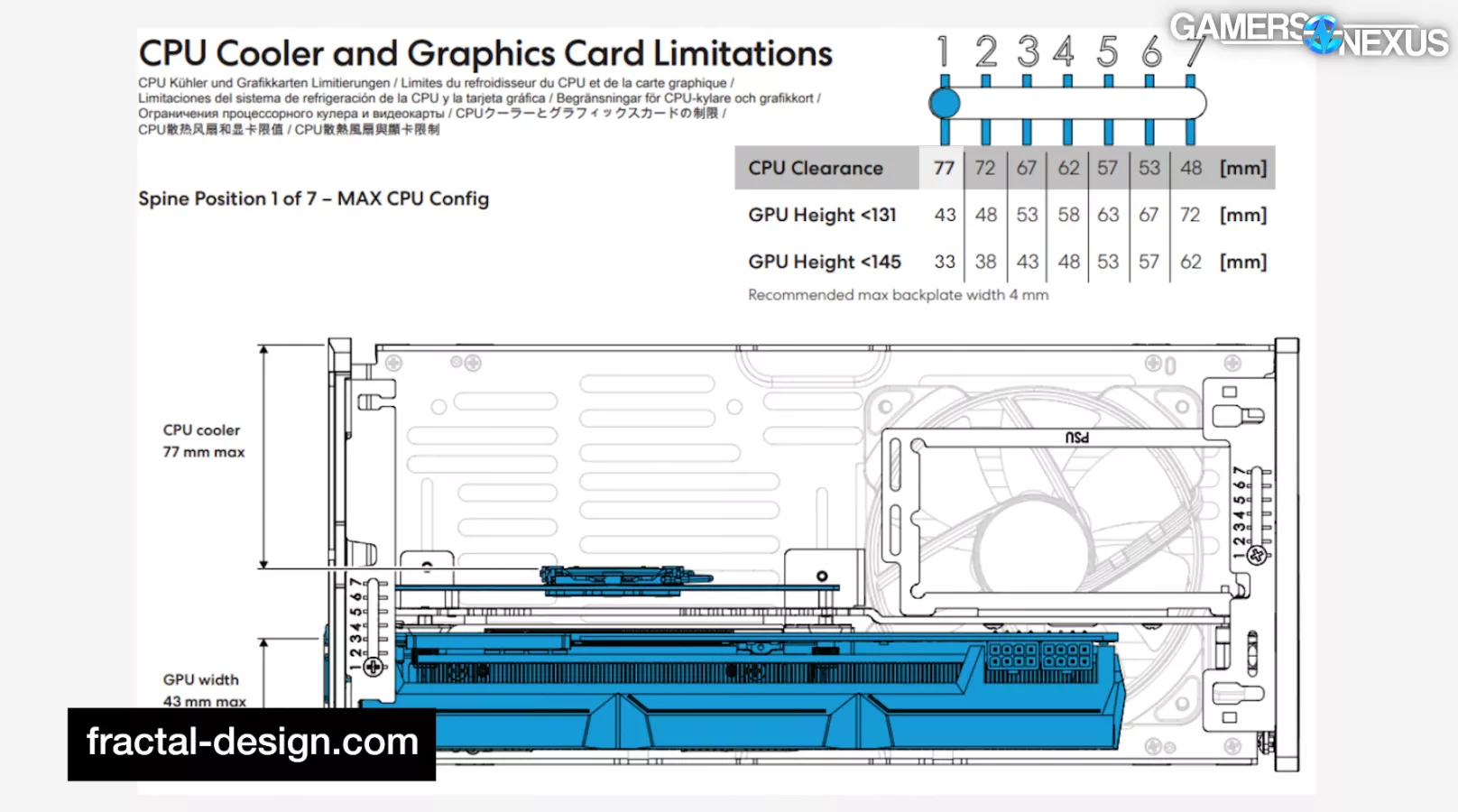
That would have the GPU clearance at 43mm depth, which would fit a 2.0-slot card with about 1-3mm of clearance, depending on tolerances. The maximum GPU cooler space is 72mm, which would have the CPU clearance at a heavily reduced 48mm. A 4090 FE is about 61mm wide - but it wouldn’t clear vertically. More on that later.
At 77mm of CPU cooler clearance, coolers like the Noctua NH-L9x65 would fit at 65mm or the DeepCool AN600 at 67mm (which is what we used). The 37mm tall Noctua LH-L9i would fit in the 48mm clearance configuration. There are other options too, including from SilverStone, but you’re going to be extremely constrained on CPU choice if fully biasing to accommodate the GPU. It’d be an imbalanced build.

For other dimensions, the Terra is 343mm long, 153mm wide, and 218mm tall, with an external volume of 11.4L. The Lian Li O11 Air Mini is 44.2L, the A4-H2O is 11.1L, and the Xbox Series X is 6.9L.
Methodologically, we’ve decided to stick with exterior dimensions including protrusions like case feet for volume calculations whenever we can. We think it’s disingenuous to use numbers that don’t represent the actual final configuration. It’s a talk for another time, but Lian Li wanted to exclude PSU and drive cage protrusions from its upcoming case from dimensional measurements -- but people still need to know about those true dimensions to make sure it fits in the room properly.
For cooling, the Terra doesn’t come with any fans, and the manual only shows an optional step for mounting a single 120mm fan in the bottom under the PSU -- but that’s not possible with an SFX-L PSU. You can technically slot two slim 120mm fans underneath the case -- there are screw holes for them -- but it isn’t an officially recommended configuration. We’ll come back to cooling in the thermal section later.
Fit and Finish
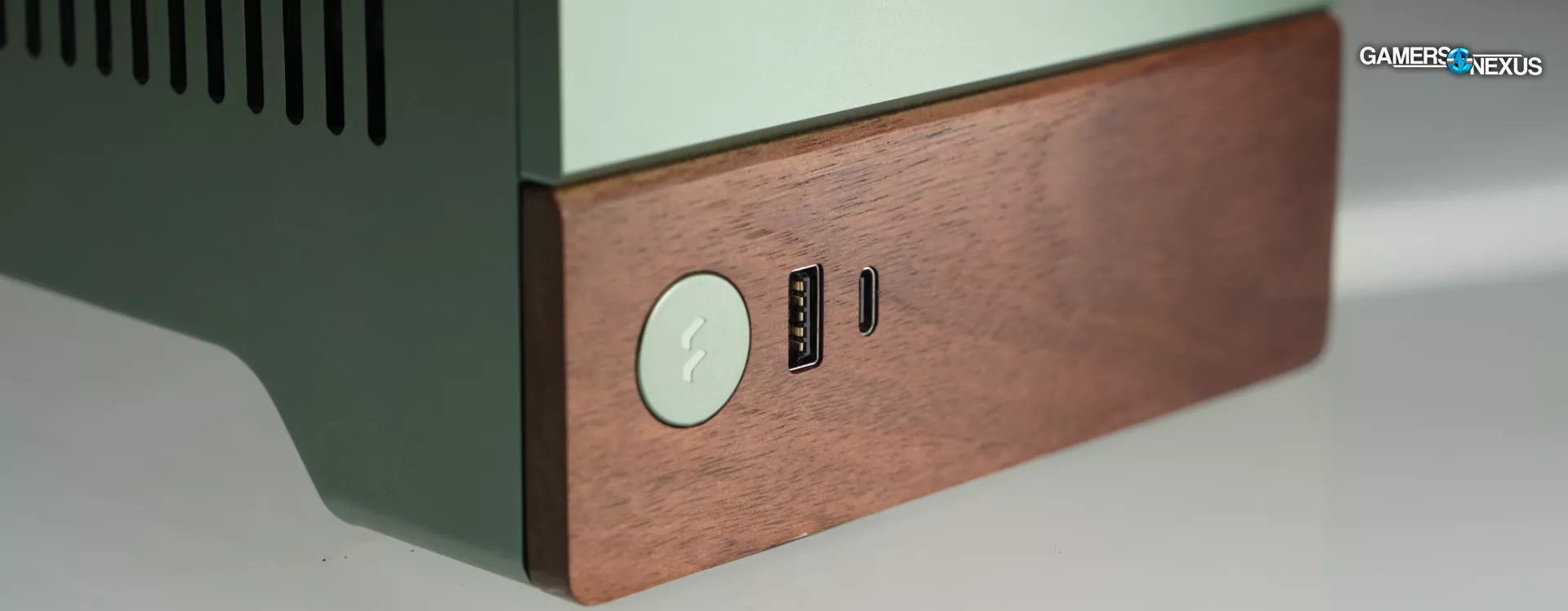
Time to get into fit & finish: The Terra’s overall build quality and finish are good. The front panel features a small strip of wood along the bottom where the limited front I/O is located -- the type of wood depends on the case color. The power button is color-matched aluminum, which is a nice detail. Front IO itself is extremely limited and doesn’t include audio, which we’d like to have seen.
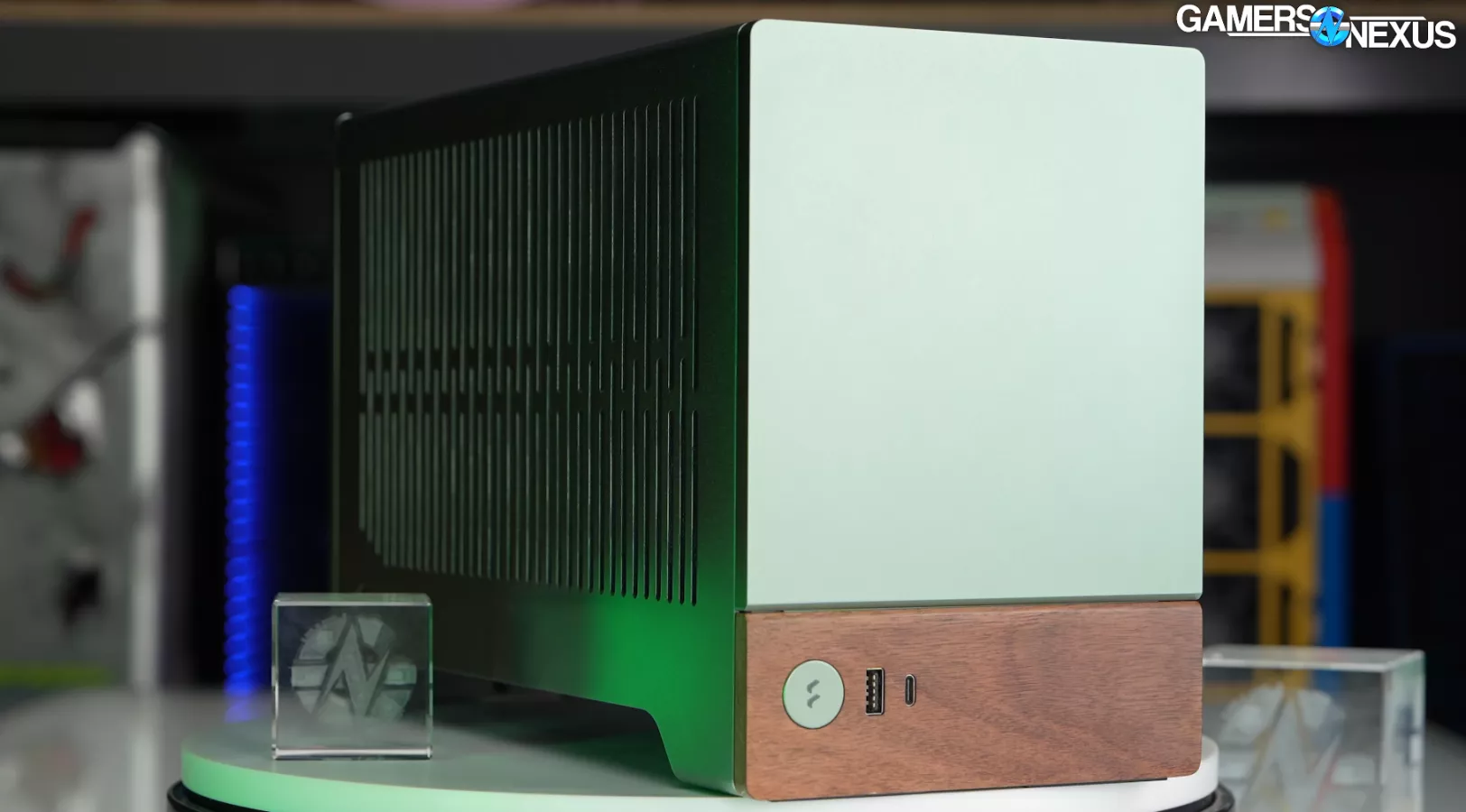
For materials, the aluminum exterior looks and feels high-end on this model, although the black version of the case that we saw at Computex seems like a future fingerprint and scuff problem. The Terra uses thick metals all over, up to 8mm in some spots, on both the outer panels and steel internals. This gives it a sturdy and rigid feeling while the case is empty.
Once loaded up with parts and moving it around, there’s some flex, but not to a problematic degree. The movable spine feels secure when all 4 adjustment screws are tight.
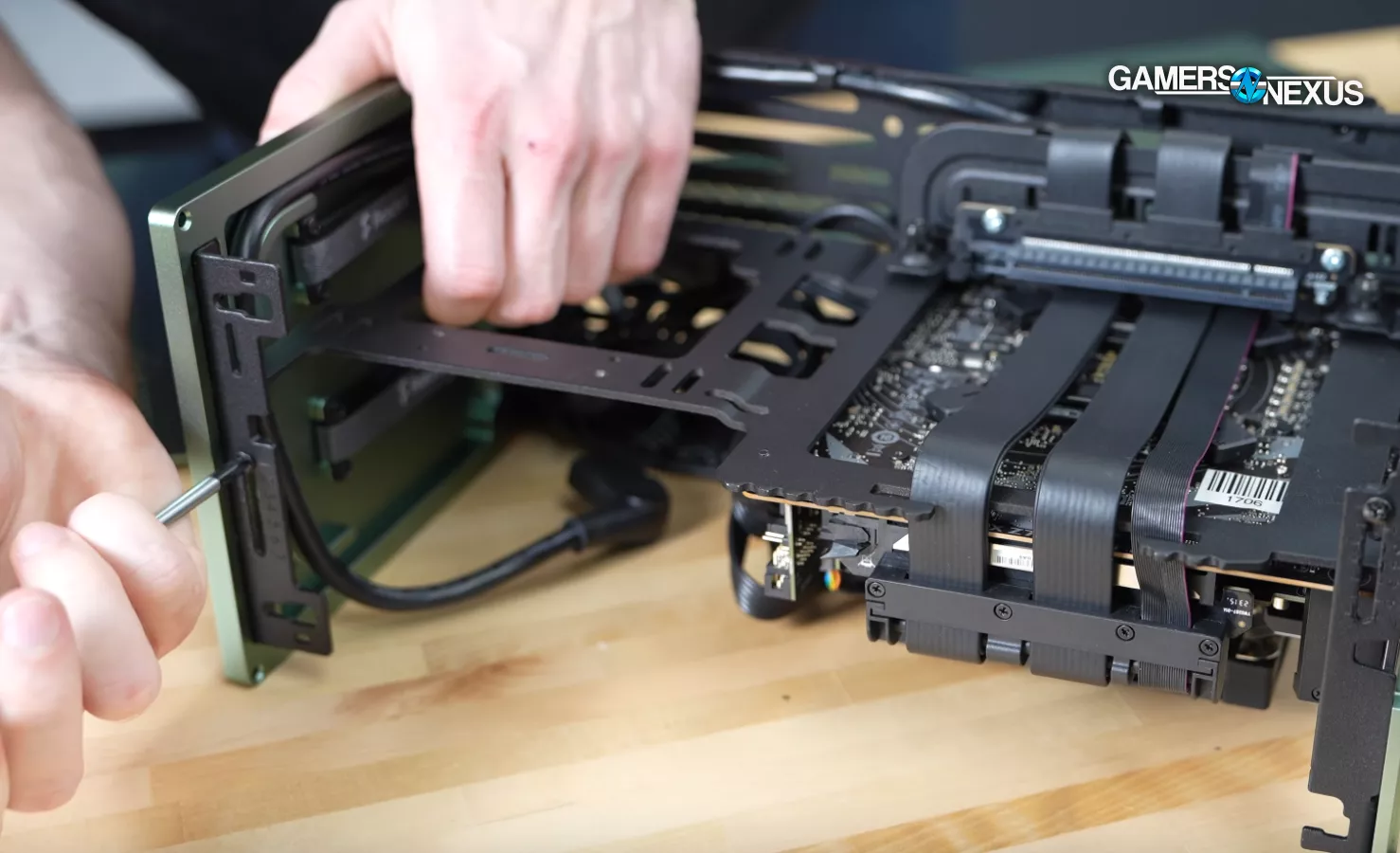
One exception to the sturdy feel are the latches for the gullwing doors. They use a small nub of plastic to act as the end of travel for the door’s pivot. Lack of care in opening the door all the way or accidental pressure could probably break this off. We’d prefer to see an alternate solution that doesn’t turn the entire door panel into a lever against such a small plastic part.

Because of this, we recommend removing the door entirely any time you build or do maintenance that’s more involved than just plugging something in.
The Terra comes with basic accessories, most notably a sled for an extra 2.5” drive and standoffs for the PSU mount – we’ll come back to those later.
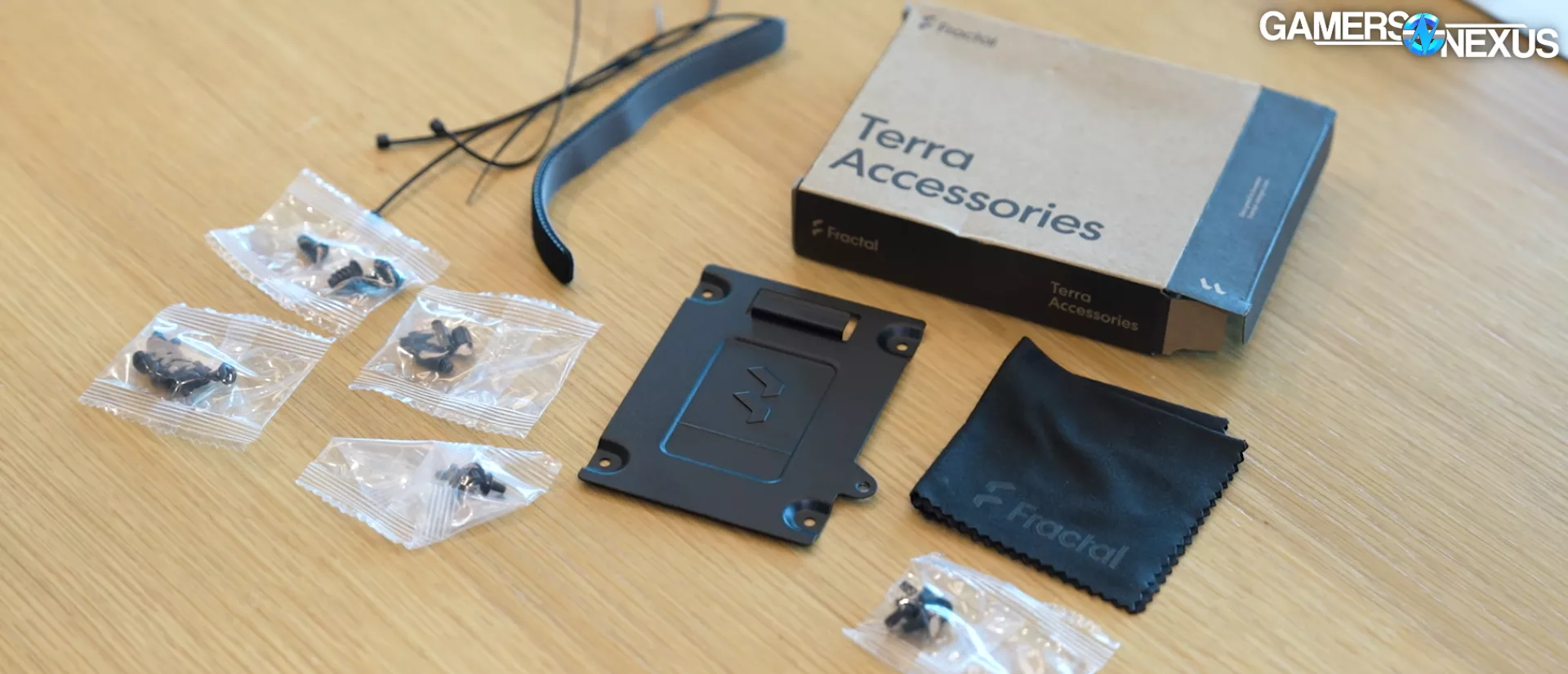
The manual is mostly good: It shows example configurations and major component clearances, although we don’t like its representation of how tightly folded the GPU power cable is.
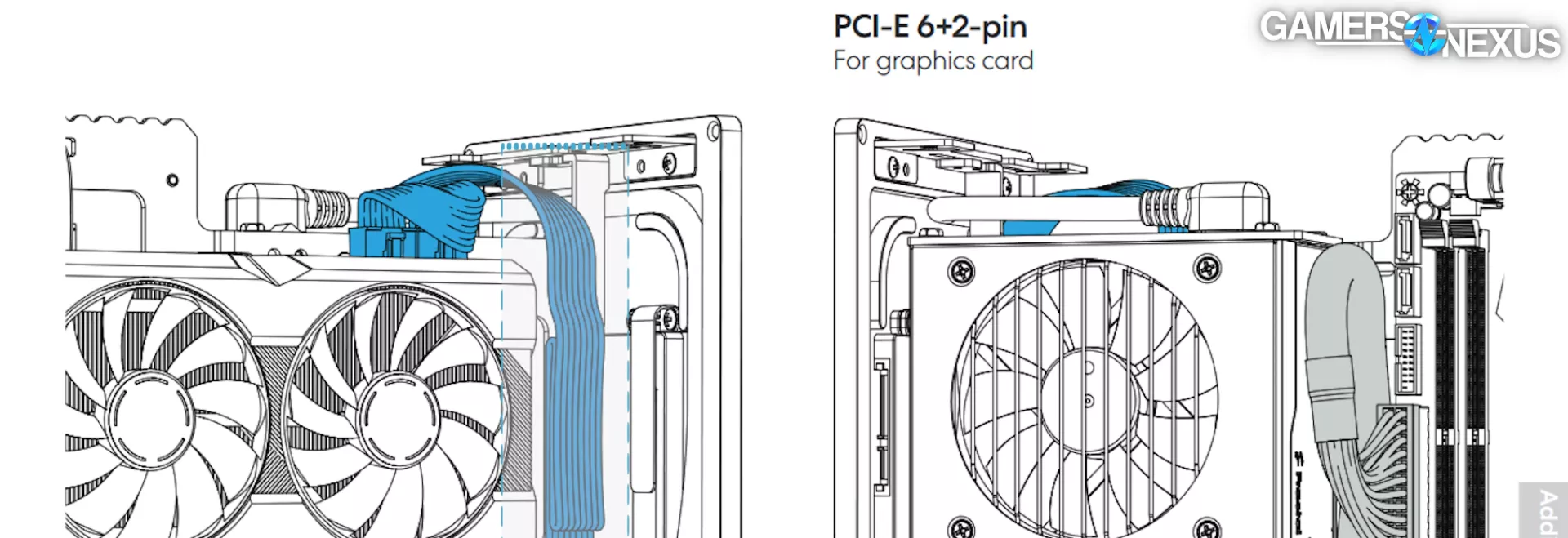
Fitment & Clearance
CPU Cooler Fitment
We already briefly covered cooler fitment, but there’s also technically an option to install a 120mm radiator, but it severely limits how long of a GPU you can use. It just comes off as an afterthought or ticking a box for marketing.
Also, fitting the pump of a CLC through the cutout under the PSU isn’t possible without removing the entire bottom of the case, which is not an operation detailed in the manual and probably shouldn’t be done unless necessary.
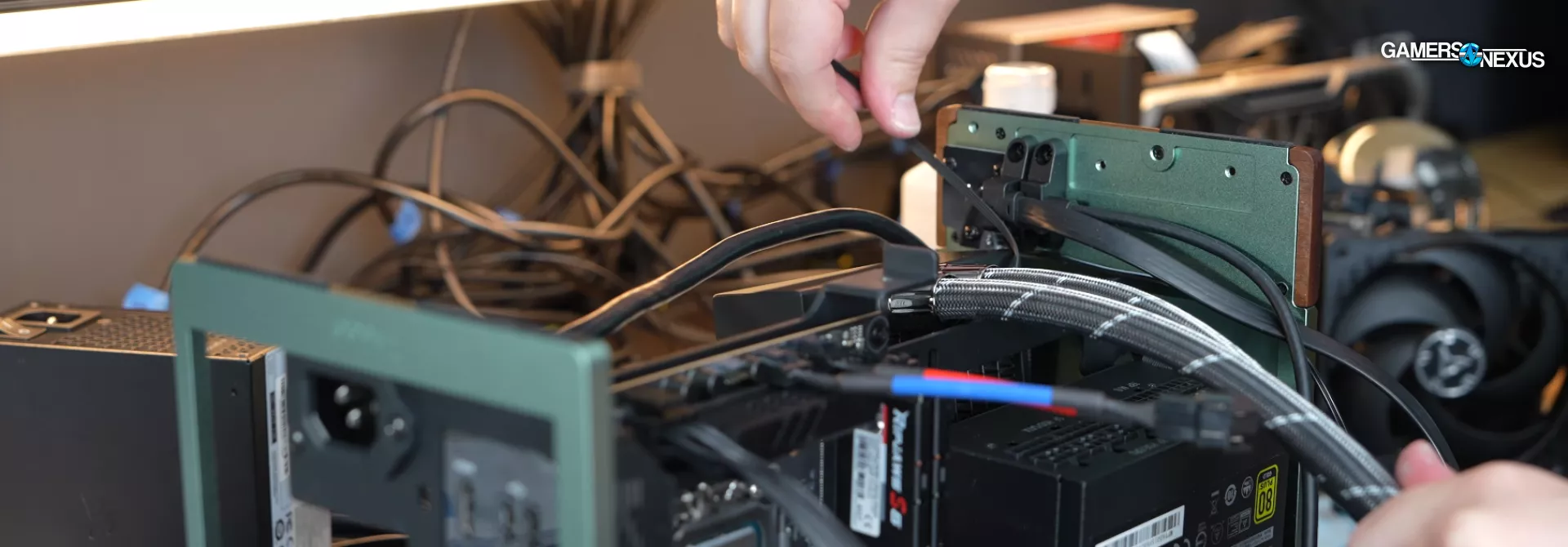
We noticed with our downdraft cooler that the cooler’s fan is partially blocked off by the solid portion of the side panel door. The vents should continue lower down the panel, but we think Fractal did this so that the end of the vents visually line up with the top of the wood on the front panel.
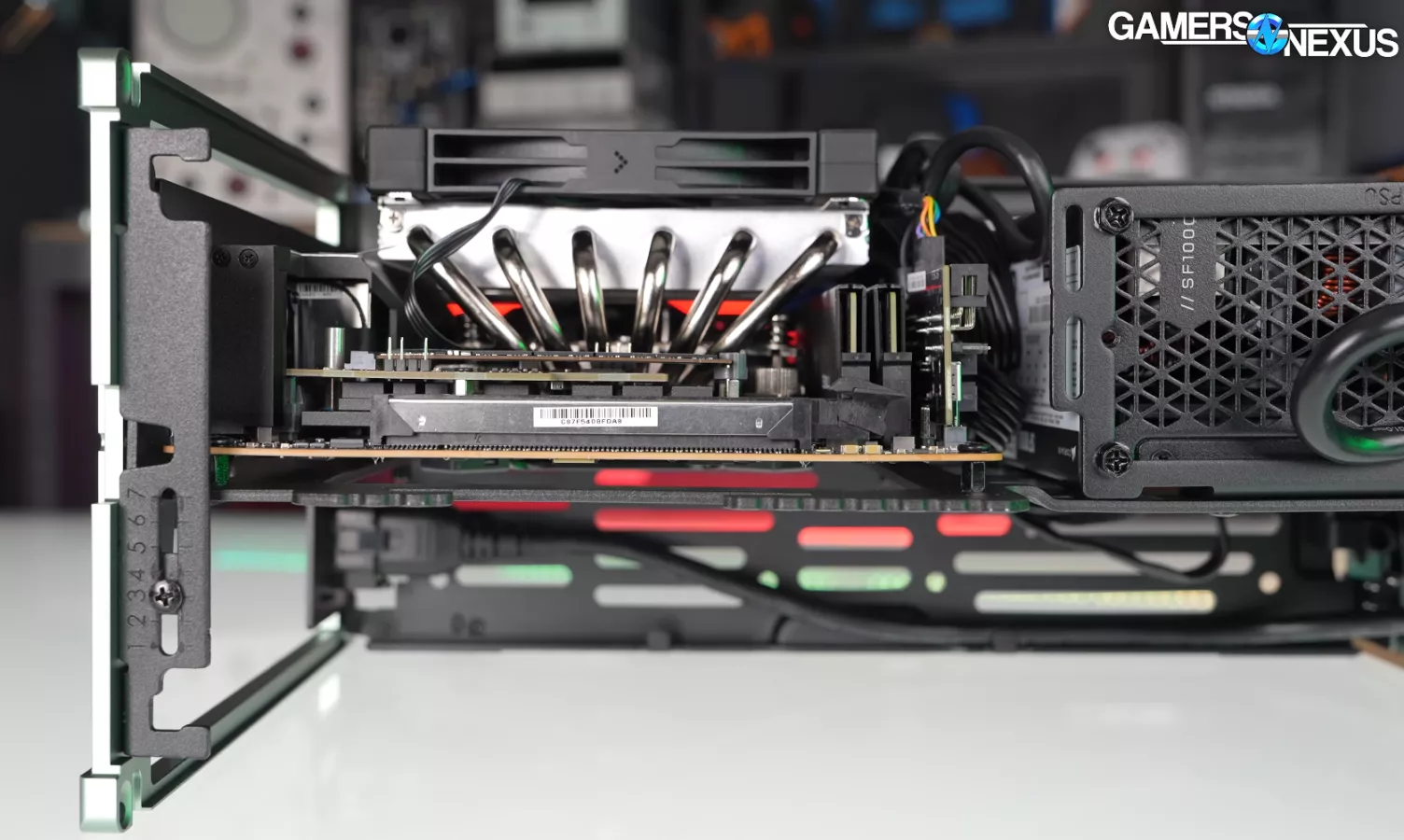
Bad Noise Quality
The CPU cooler fan is loud and annoying when it’s right behind the slats in the side panel. Long slats are bad for noise, and a different ventilation shape would help. We did a quick test of some other side panels smashed against the case just for a quick demo. You can find that in the video.
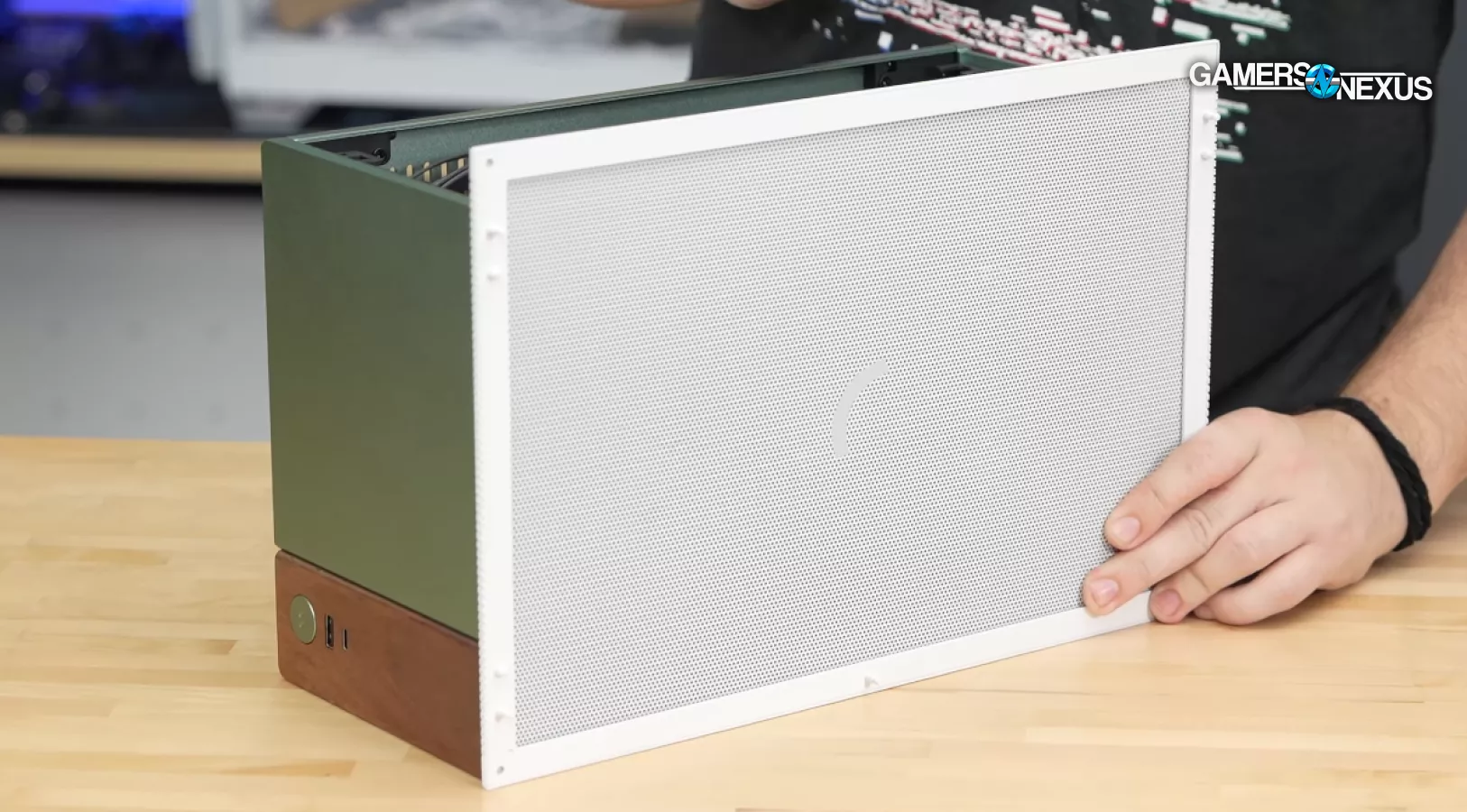
We found the fine mesh of the ssupd Meshlicious/Meshroom to have the most agreeable noise profile. That’s also a common material for ATX cases.
Since you can’t actually replace the side panel short of removing it entirely, your options are to lower fan speed or move the spine to get the fan farther away from the panel. We’ll get to our detailed objective analysis in the noise section of the review.
GPU Fitment and Installation
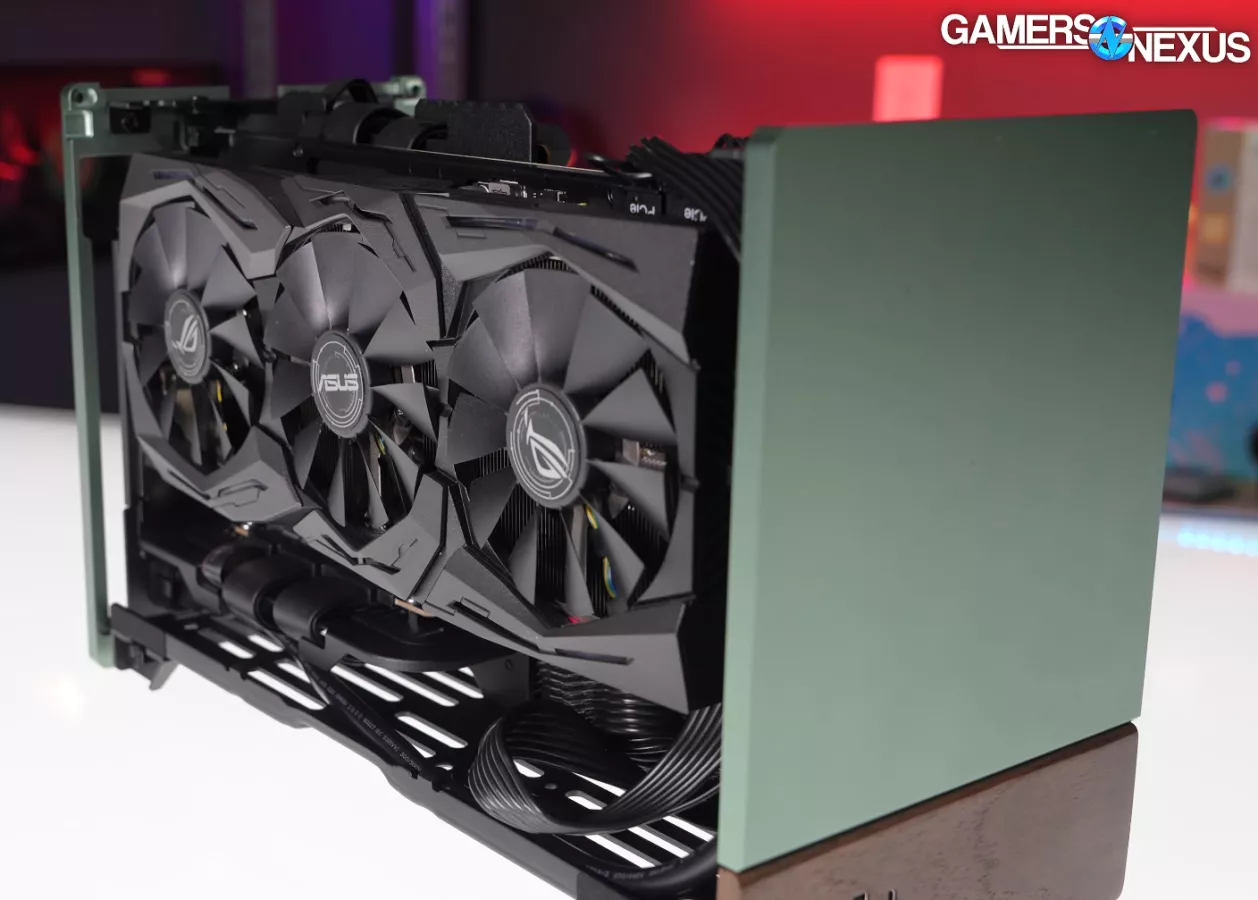
The entire left side of the case is devoted to the graphics card, so GPUs up to 322mm long will fit. Maximum thickness has some caveats, and depends on both the spine position and the height of the GPU. With the spine in position 1, GPUs vertically shorter than 131mm can be up to 43mm thick, and GPUs that measure 131-145mm vertically are limited to 33mm. With the spine in position 7 for max GPU space, those change to 72mm and 62mm thick, respectively. One slot of thickness is 20mm, for reference. The RTX 4070 FE we’re using for testing measures 244mm long, 112mm tall, and 40mm thick.

We test fit a few other GPUs to see what fit issues may come up. The reference RX 7900 XTX fit with the spine in position 3 without issues. The tallest card we had on hand was this ASUS Strix Vega 64 at 139mm, and it fit with the spine in position 3 as well, but uses nearly all of the vertical space. The RTX 4080 FE required biasing the spine farther towards the CPU side, reducing the cooler clearance significantly. GPU power cable management can be tricky on the taller cards, and the Corsair SF1000L’s stock 12VHPWR cable is so stiff that we weren’t comfortable forcing it to bend enough to fit. If you’re interested in using a GPU this tall, you’ll need a more flexible individually-sleeved cable or some kind of 90 degree adapter.
PSU Fitment and Alternate Mounting
PSU support includes both SFX and SFX-L. The SF1000L fits, but the cables need to be preinstalled when mounting it because there’s not enough room below the PSU to comfortably plug one in after the fact.
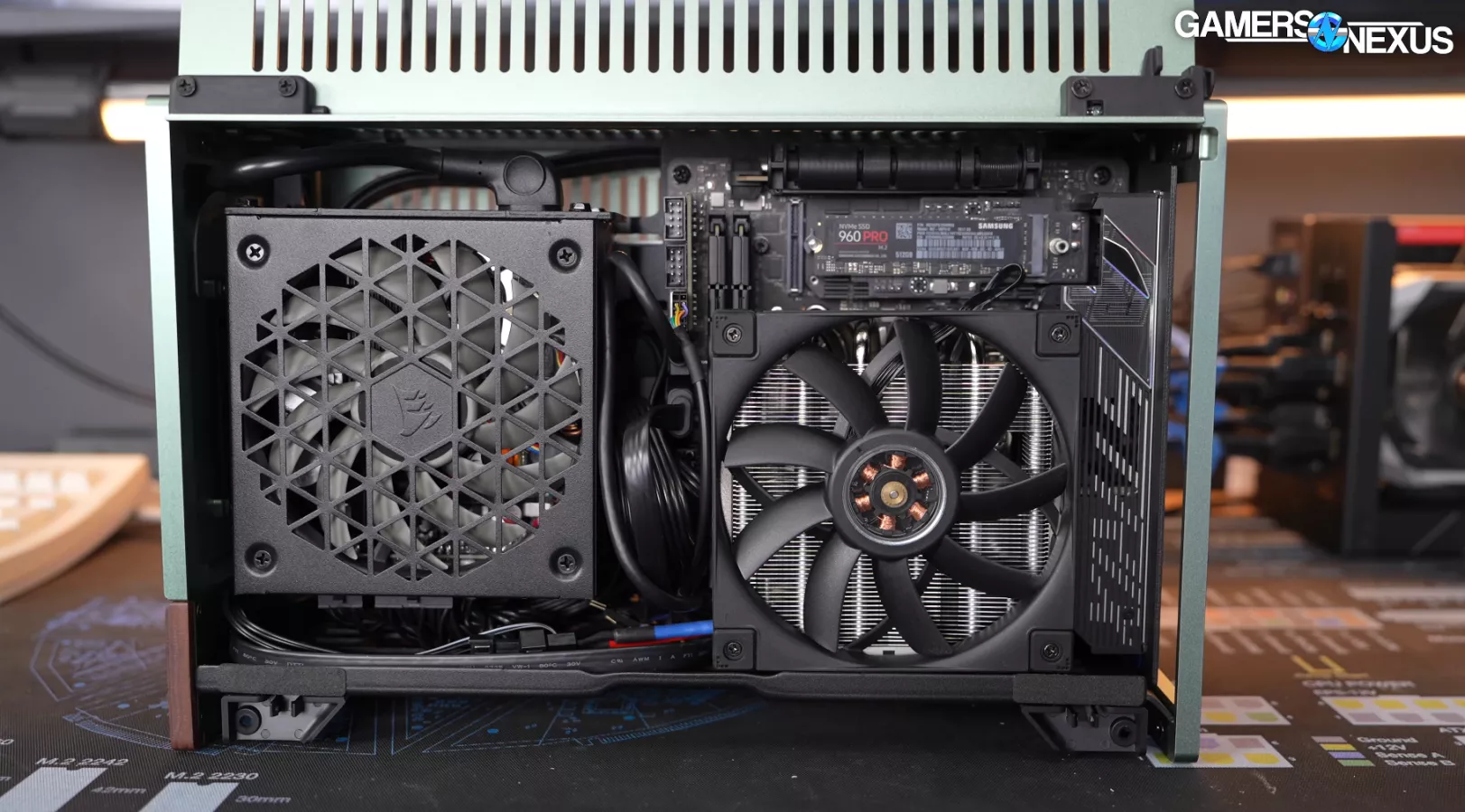
The other downside is that SFX-L eliminates use of the floor-mounted SSD sled or fan mount. Unless you need the extra power SFX-L affords, we recommend sticking to true SFX PSUs in the Terra just for ease of use and flexibility. Fractal could have made this a little better by having the PSU bracket mount just a little higher within the chassis. There’s a few wasted millimeters of empty space between the 90-degree AC power cable and the top panel that should have been taken advantage of. When it comes to mini-ITX cases, careful and efficient use of space is very important – everything helps.
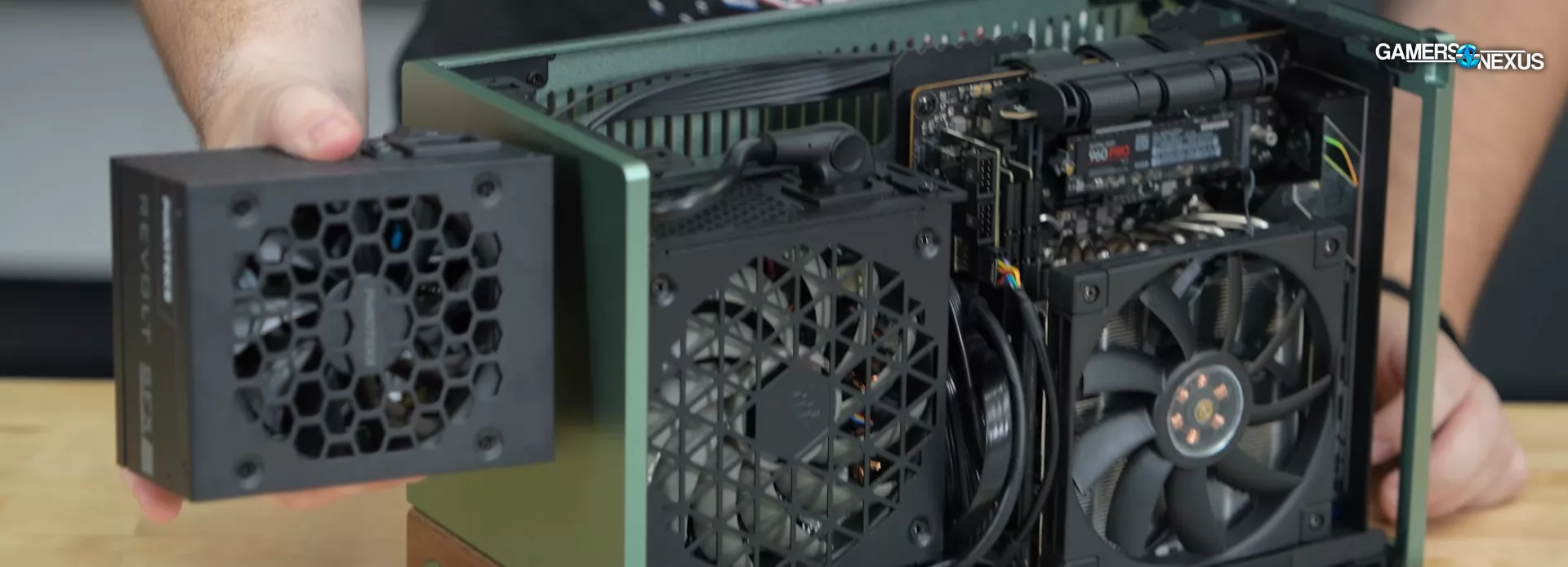
We’d also recommend pre-installing the EPS12V cable with the motherboard end of CPU power. Our choice of CPU cooler and orientation prevented access once the board was mounted. Installing the cooler after the board is in could also work.
Testing Methodology, Acoustics, & Peer Review

Our methodological choices and details on our acoustic chamber, including our peer review process for acoustic data, can all be found in the video for this review. We can also recommend this video to learn about our hemi-anechoic acoustic chamber:
The main discussion point in the video is that mini-ITX cases are impossible to review in a fully standardized way without shorting some of the cases. A large part of the point of ITX is to fit the most in the least, and so standardizing cooler selection would mean limiting how useful -- for example -- the "H2O" aspect of the DAN Case A4-H2O is if we were to use a downdraft cooler. Likewise, switching coolers between cases and putting them all on the same chart effectively becomes a cooler review, not a case review, which we do separately. To control and limit variables as much as possible, we are largely looking per-case for ITX reviews (whereas our ATX reviews can be more standardized).

GN Mini-ITX Variable Test Bench (2023)
Our test bench is below for ITX testing. Note that this particular bench is variable, and as such, there are multiple variations listed per component category. If any of the parts you see in our build interest you, you can likely find the links to their retail pages below:
| Part | Standard Component(s) | Provided By |
| CPU | Intel i5-13600K @ Fixed clocks & voltages (clocks/voltages determined per case; we may settle on permanent settings once we get past our first few ITX case reviews) | Bought by GN |
| GPU | NVIDIA RTX 4070 FE | NVIDIA (review unit) |
| Motherboard | ASUS ROG Strix Z790-I Gaming WiFi | Bought by GN |
| PSU | Corsair SF1000L 1000W SFX-L Phanteks Revolt SFX 850W | Bought by GN Provided by Phanteks |
| RAM | GSkill Ripjaws S5 2 x 16GB | Bought by GN |
| SSD | Samsung 960 Pro M.2 NVMe SSD | Bought by GN |
| Coolers | VARIABLE Standardized options: 240mm CLC: Fractal Design Lumen S24 v2 RGB 120mm CLC: Arctic Liquid Freezer II 120 "Standard" Tower: Scythe FUMA 3 or Deepcool AK400 Short Single Tower: Noctua NH-U9S Mini-Tower: Noctua NH-D9L Downdraft Low-Profile: Deepcool AN600 67mm Alt. Downdraft: Noctua NH-C14S | Fractal Design, Arctic, Deepcool |
| Additional Fans (Optional) | VARIABLE Standardized options: Arctic P14 Slim PWM PST 140mm Arctic P12 Slim PWM PST 120mm Arctic P8 Max 80mm Noctua NF-A6x25 PWM 60mm Noctua NF-A9x14 PWM 92mm | Arctic Noctua |
Let’s get started.
Fractal Terra Noise & Acoustic Testing
Frequency Spectrum Plot
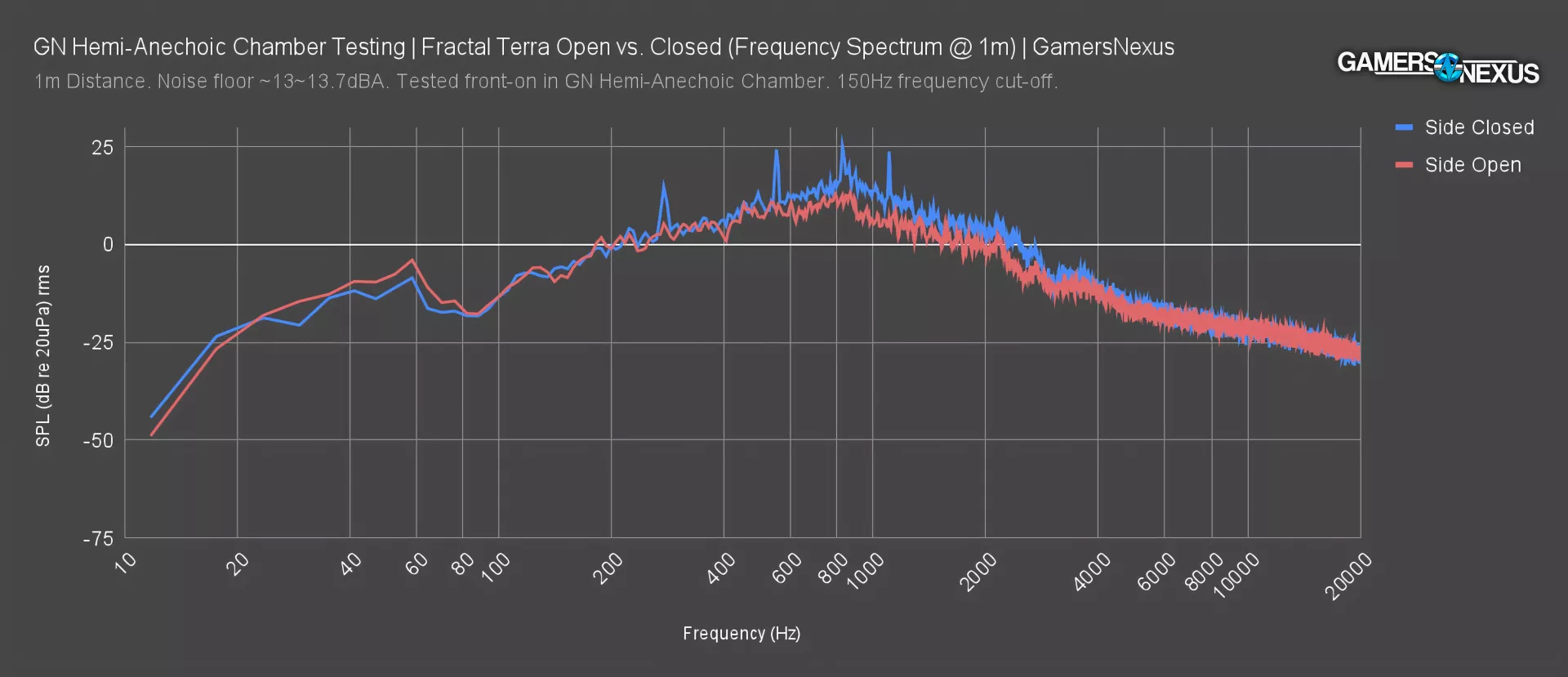
This frequency spectrum plot shows what’s going on. With the side open, the case isn’t only quieter overall despite the same fan speeds, but its noise reduction primarily comes from the 500Hz to 4000Hz frequency range. The biggest deviation is around 850Hz, with reduced but also deviating spikes from 600Hz to 1100Hz.
Audition Visualization
The previous chart was made with special acoustic testing software, but this next image is from something simpler: Adobe Audition, which is used for sound mixing. These are unmodified frequency visualizations. This first image shows the case with the side open. Note that most of the noise is a lower fan hum -- primarily under 200Hz. Here’s the side closed test. Notice that we have a higher volume of 600Hz, 800Hz, and 1100Hz noises now. We’ll flash between these a couple times to make it easy to see the differences. The total volume is also just higher with the sides closed in our testing with the spine biasing the CPU cooler towards the side panel, but it’s those specific ranges that make it annoying.
As a last demo, we’ll isolate the range of about 750Hz to about 1000Hz so you can hear that specific annoying tone:

For noise comparisons, check out the video above.
Total Noise Levels
This last charge just shows the total noise levels. The absolute number doesn’t matter much here -- remember that you can control your fans to affect the noise, and this case has no fans, so all we’re really testing is how the cooler fans interact with the case panels. The noise level is significantly lower -- about 5.6dBA reduced -- with the panels open. That’s despite exposing the fans more directly to the outside of the case, so this just proves the slats conflict.
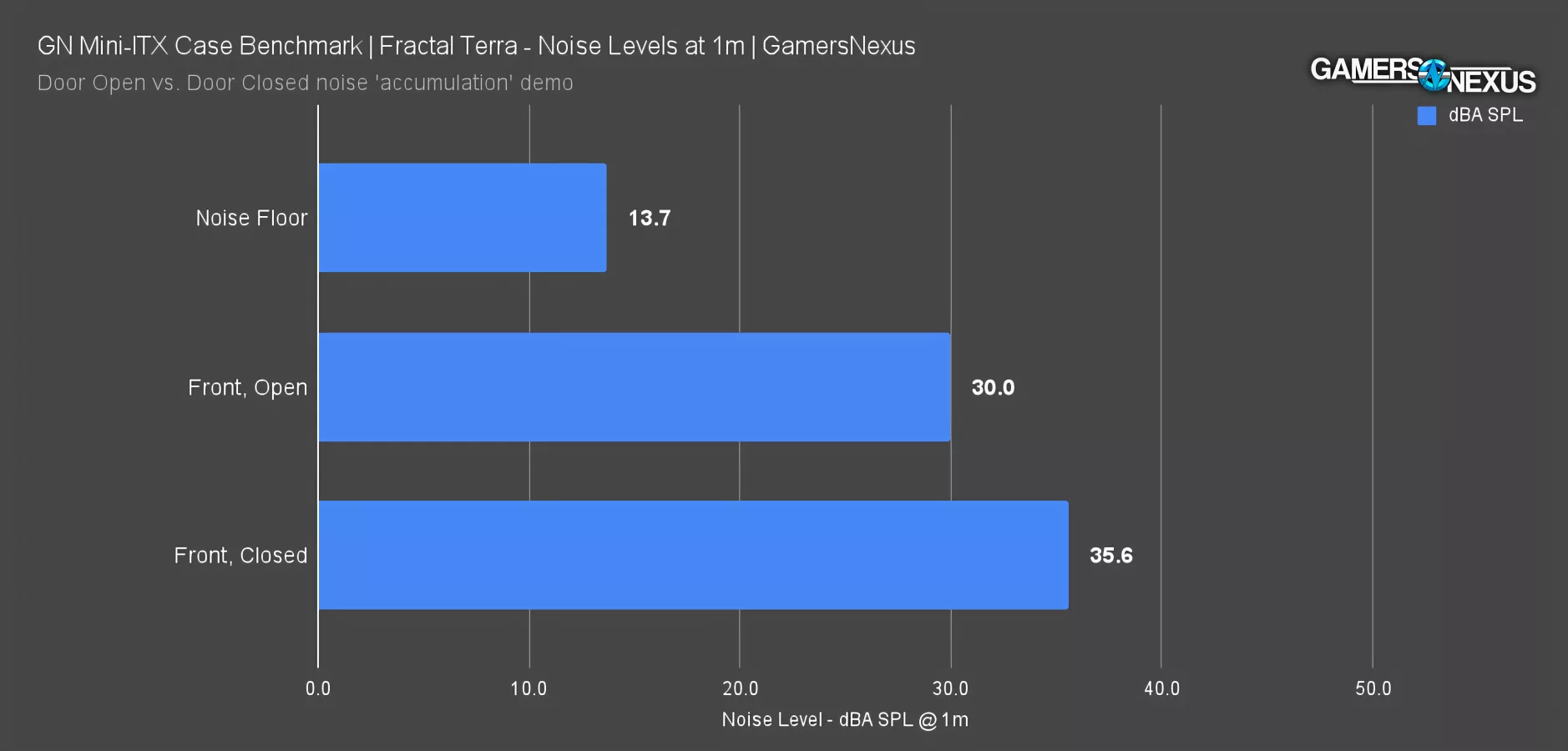
Thermals
With that, we’ll move on to thermals.
Fractal’s webpage for the Terra says, “make the most of natural airflow through the ventilated top, side, and bottom panels.” We assume Fractal is referring to the fact that hot air rises, but as we’ve said before, that doesn’t have much to do with cooling in a case when there are fans involved. They’ll overpower heat rising every time -- air will come from anywhere it can. Without case fans, you’re relying entirely on the CPU cooler, GPU, and PSU just like an open-air setup – except it’s not open air.
It’s important to understand that the numbers we’ll show here are only comparable amongst themselves. You can’t compare them to other cases directly, unless the other case explicitly uses the same hardware, BIOS configuration, and fan speeds. For now, we only have the Terra against itself in various configurations. We’ll occasionally add competing cases to the charts as we move forward with more ITX reviews.
Our “stock” setup in the Terra has the spine in position 3, which is as close as we could run it to the middle 4 position it comes set to out of the box. The AN600 CPU cooler has its fan at 100% speed and the RTX 4070 FE has its fans locked to 44%. Frequency and voltage are locked.
Remember that noise-normalized testing is only useful in the comparative. Doing such testing in a case against itself serves no value.
CPU Thermals - Full Torture

Here’s the first chart. Under a full system torture workload at steady-state, the P-Cores averaged 58.6 degrees Celsius Delta T over Ambient. The full all-core average was a little lower, since E-Cores pull less power and run cooler. To determine how much the side panels are restricting air, we next tested with the side doors fully opened: Here, the P-Cores dropped by 3 degrees, so that should be considered our best possible outcome with this setup. The difference is greater with the GPU in a moment.
Adding two slim 120mm intake fans to the bottom only improved from baseline by 1.4 degrees, which is close to run-to-run deviation. It’s not worth all the noise and hassle to add slim fans to the bottom. It’s not an advertised configuration, and for good reason: There’s not enough table clearance for these fans to breathe.
Sliding the spine over to position 1 for as much room on the CPU side as possible didn’t impact CPU thermals to any meaningful degree, staying within error; however, it did benefit acoustics greatly. More on that soon.
The alternate PSU configurations gave interesting results. The 10mm standoffs reduced baseline by about the same as the bottom fan setup; however, installing the PSU in the flipped orientation with the fan facing the GPU didn’t have a meaningful impact on CPU thermals versus stock, with the data leaning slightly warmer.
GPU Thermals - Full Torture
The GPU thermal chart is next, showing delta T over ambient steady-state averages for GPU core, memory, and hotspot temperatures.
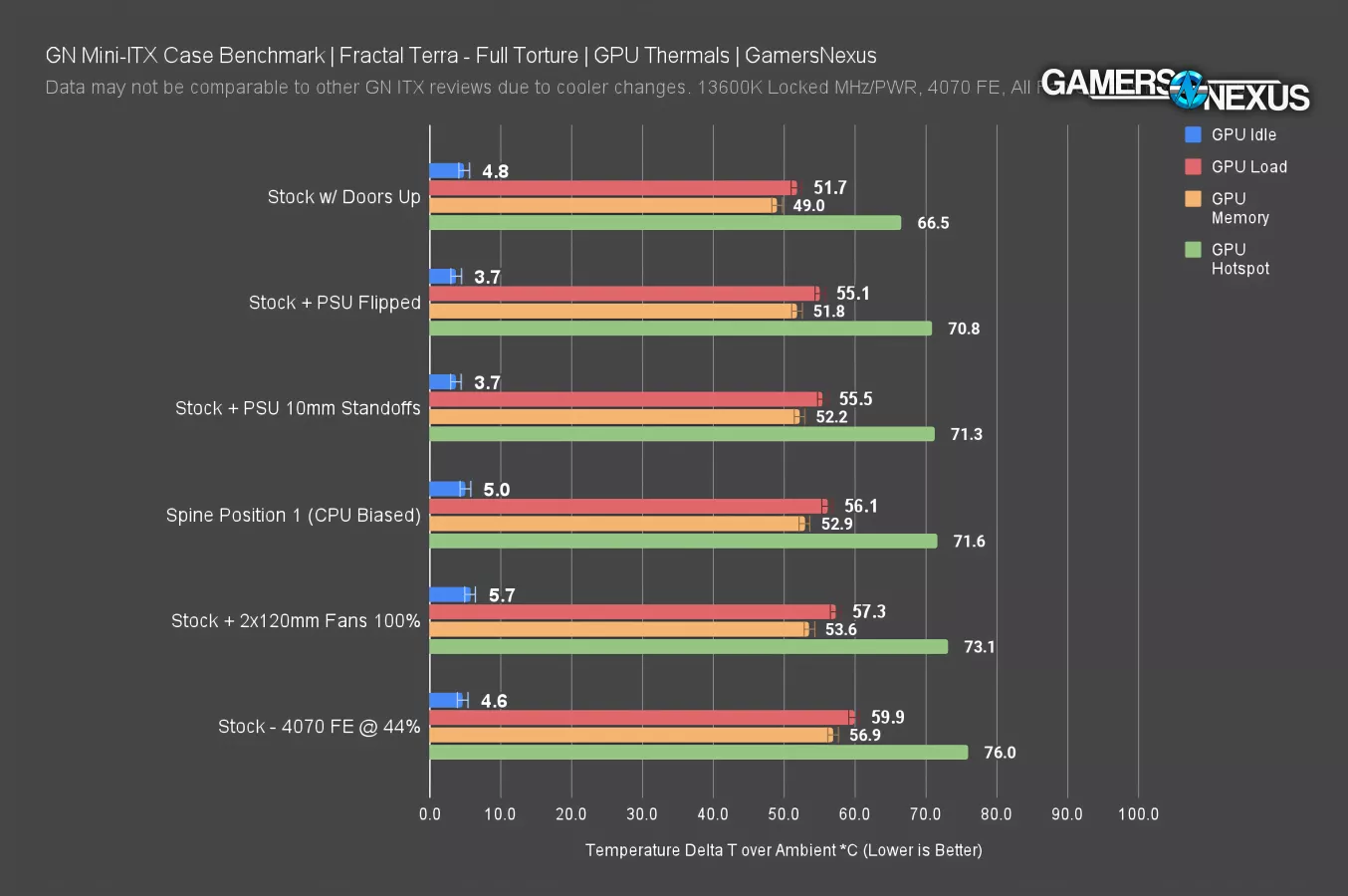
Our stock setup resulted in the worst temperatures on the chart, due to warm air recirculation in the GPU side of the case. Without any chassis fans to force it out, you actually are relying on that slow natural movement of hot air to escape through the top or through the GPU. Opening up the Terra’s gullwing doors unsurprisingly gave us the best result – 8*C lower on the GPU core and a massive 10*C lower on the hotspot reading. These are huge swings for GPU thermals, showing the restrictions caused by this style of door ventilation. A higher porosity would help Fractal here.
Adding fans to the bottom didn’t appreciably move the needle for GPU thermals either, so skip that idea unless extending the feet.
Setting the spine in position 1 dropped about 4*C from the core versus stock. That might seem counterintuitive at first since that setting gives the GPU the least space, but it’s actually better since the GPU’s intake is right up against the side panel getting fresh air rather than pre-warmed recirculated air.
The alternative PSU mounts performed identically, both better than stock for GPU thermals. Cards with a flow-through area on the cooler are naturally going to benefit from having lowered airflow restriction, which both alternate PSU installations help with. Given that the 4070 FE doesn’t totally line-up with the PSU in the Terra, this would likely matter even more with a larger or longer card like a 4080 FE or Gigabyte Aero, and less so with a traditional non-flow-through card like an RX 7900 XT. Remember that the PSU can eat more heat this way -- they can take it, but the cheapest ones could have shortened life.
Given the better CPU thermal performance, we recommend running with the 10mm standoffs on the PSU mount with the GPU as close to the side panel as possible. Of course, since each build is so different, you may need to adjust if your card produces more noise than ours did.
Conclusion

The Terra is a solid choice for an upper midrange gaming build. Our 13600KF and RTX 4070 weren’t really held back, but ultra high-end choices like a 4090 or 13900K would force you into skimping on cooling somewhere and making an imbalanced build. It’s on the expensive side at $180, and there are plenty of other options at or below that price – we’ll probably be covering the A4-H20 next.
The most obvious improvement would be changing the vent shape away from slats to fix the noise profile. We’d also like to see a future rev. 2 incorporate better access to the bottom of the case and really focus on squeezing every millimeter of space by moving the power supply mount higher.
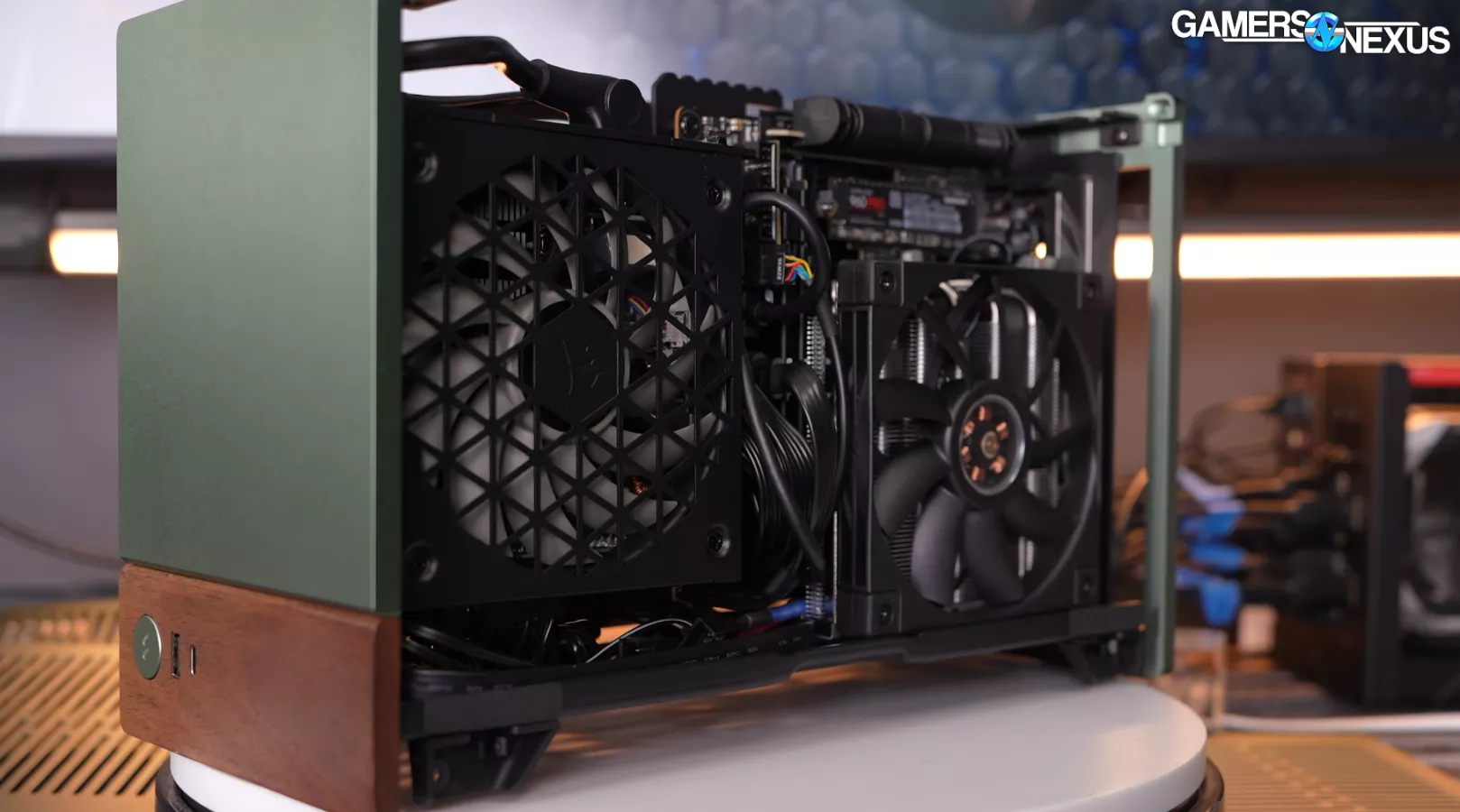
Thermals were mostly fine, with the vents in the chassis being open enough to be adequate. The support for 120mm liquid coolers feels really shoehorned in there and not very thought out. This is primarily an air cooling case, and we’d like to see a spot added for at least one exhaust fan somewhere to get the hot air out. In our testing, it was best to minimize the space on the GPU side to cut down on warm air recirculation. Adding the 10mm PSU standoffs helps for flow-through GPUs too.
While it’s certainly not the company’s first try at ITX – with cases like the Era ITX, Core 500, and Node 202 before it – the Terra has a higher level of polish consistent with Fractal’s more recent ATX releases like the Torrent and the North.
(11/9/23: Corrected a typo referring to the 'Terra' as the 'Torrent' that occurred during website setup for launch)
